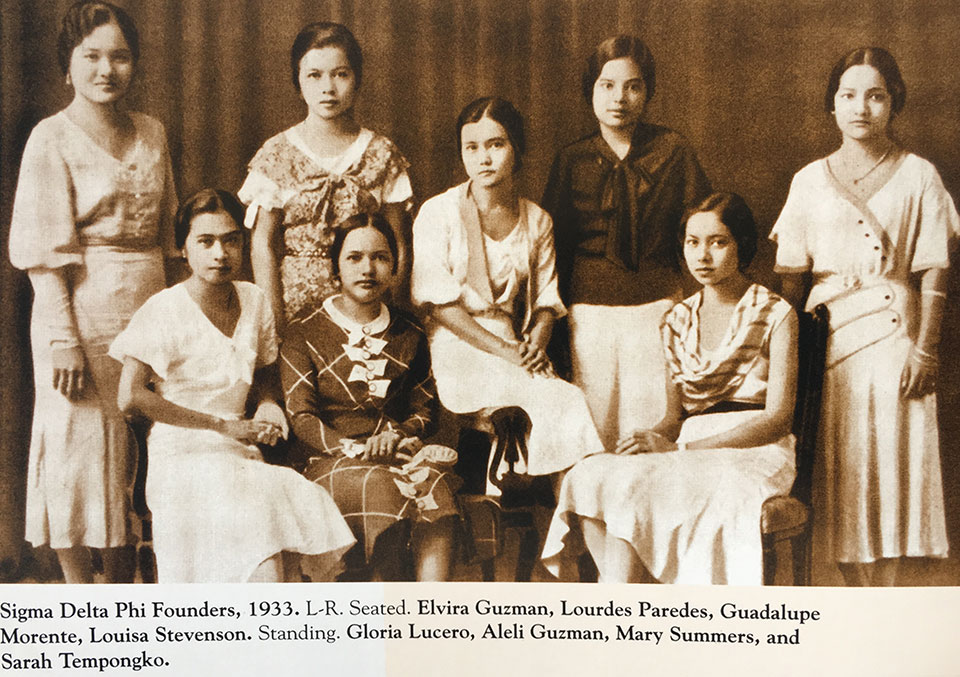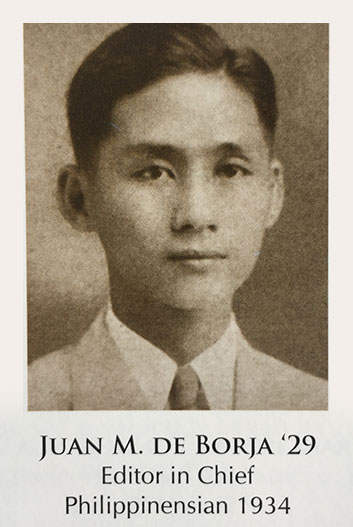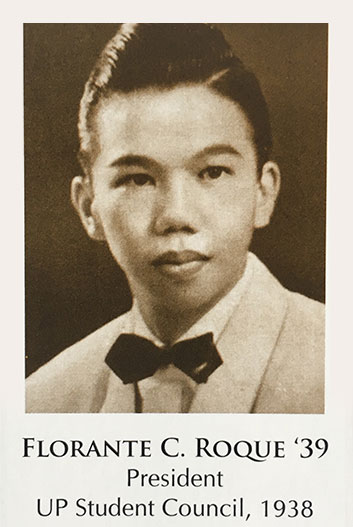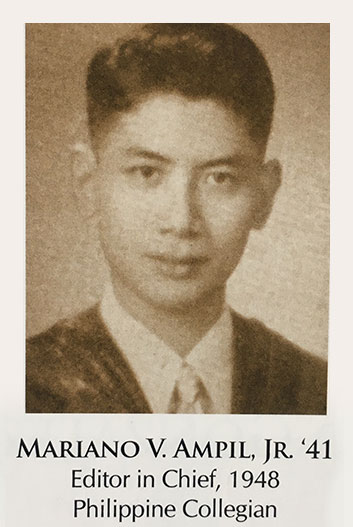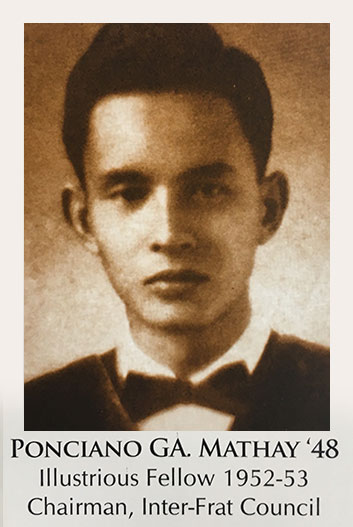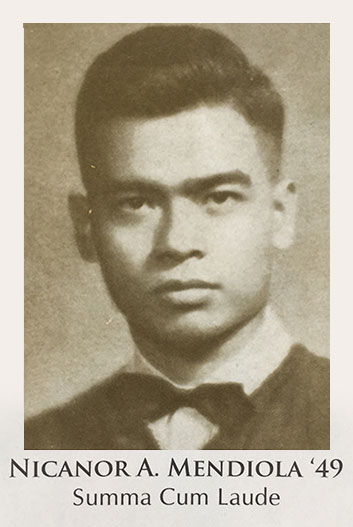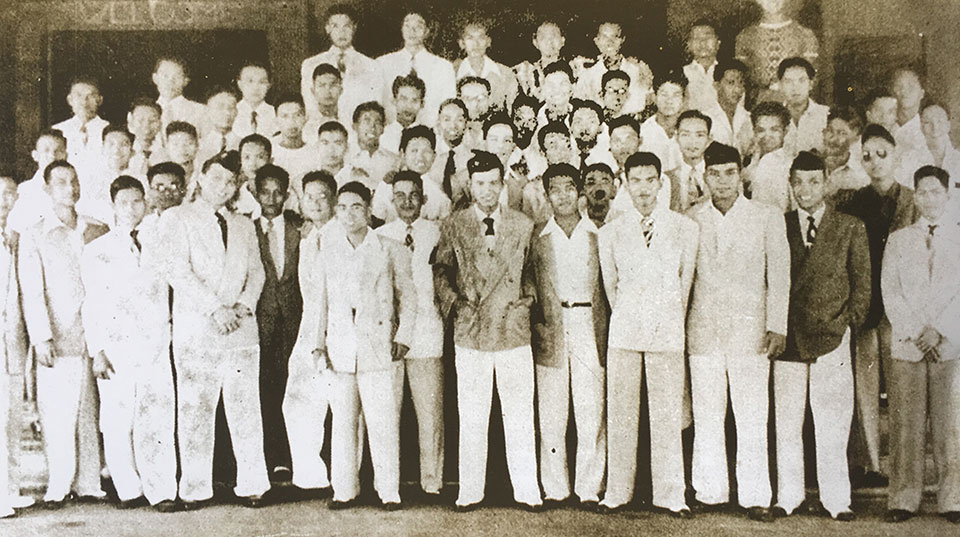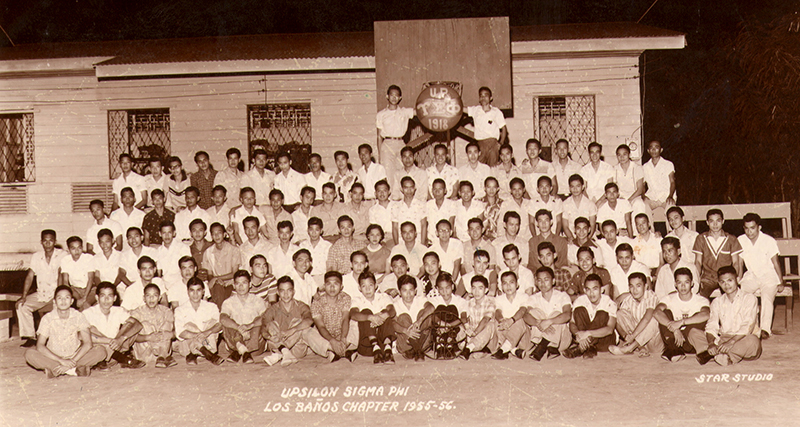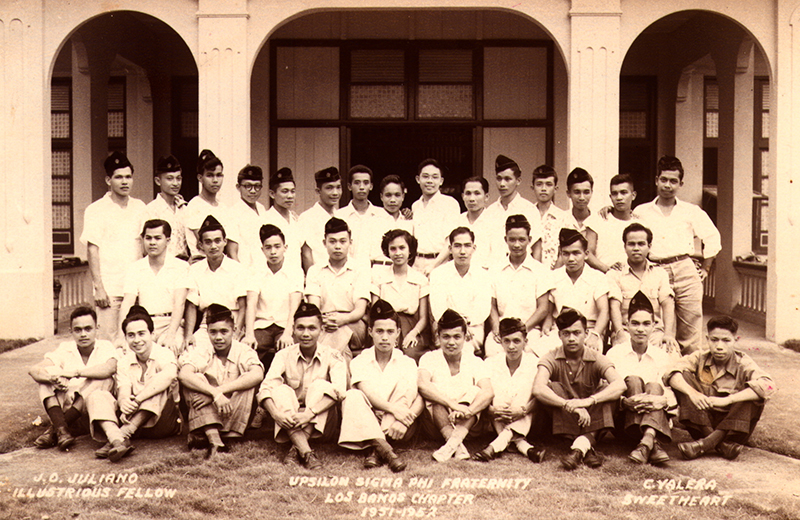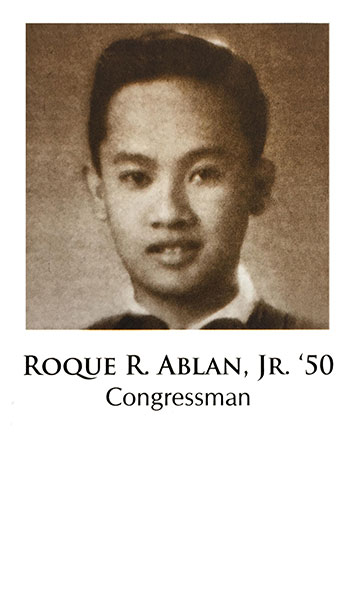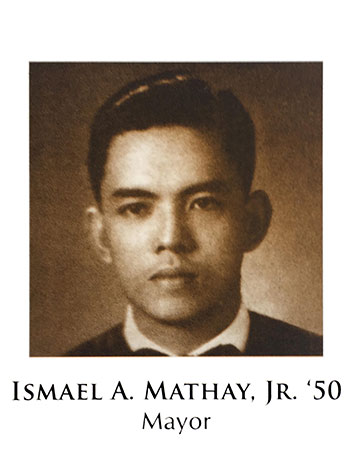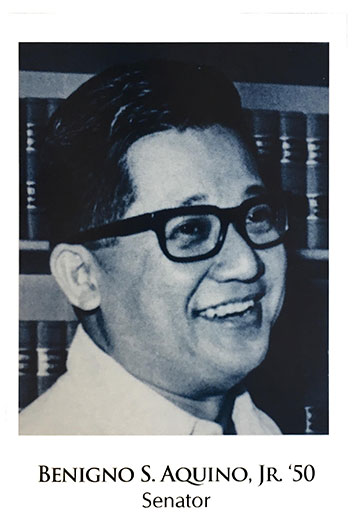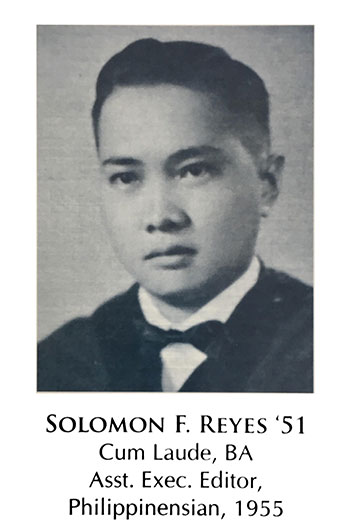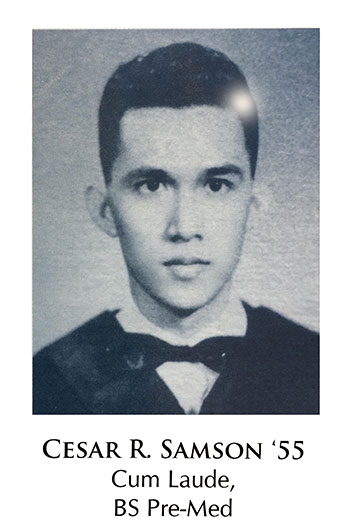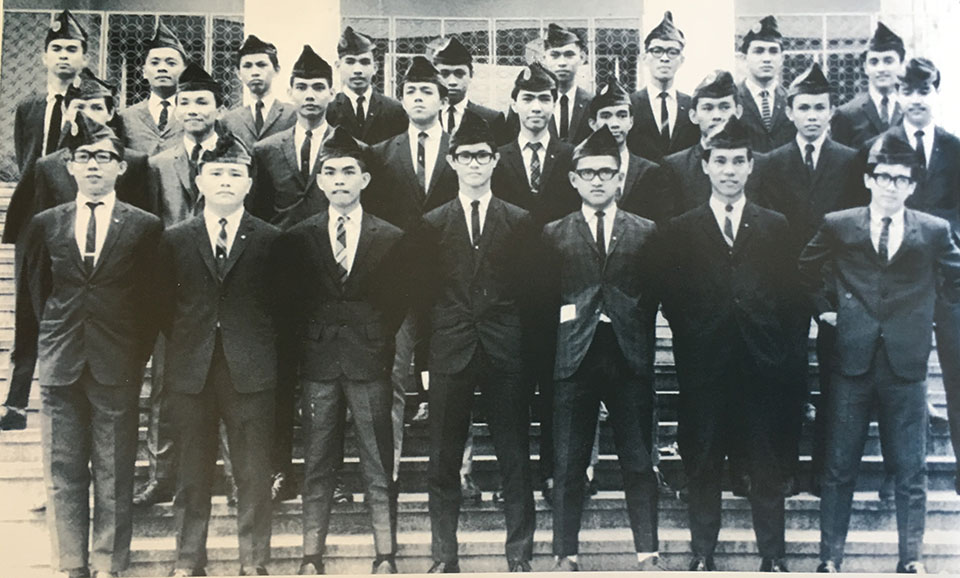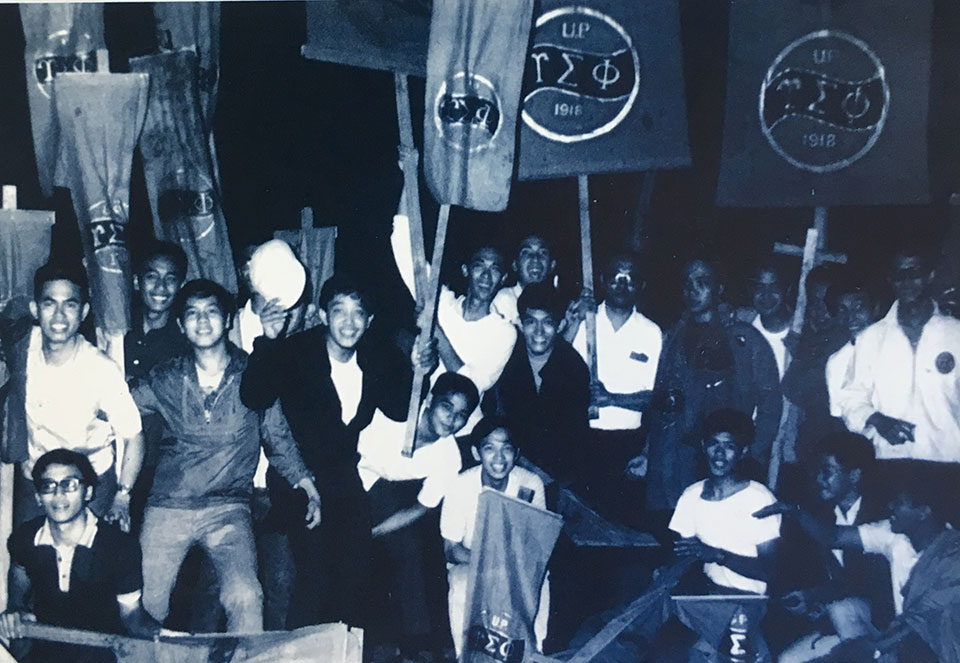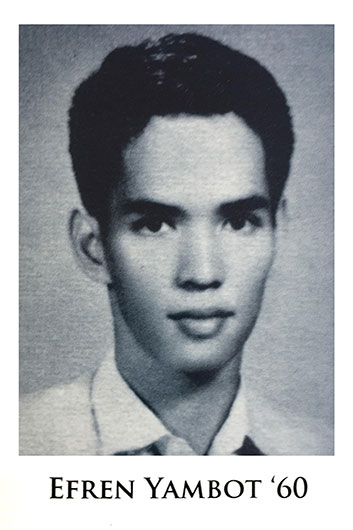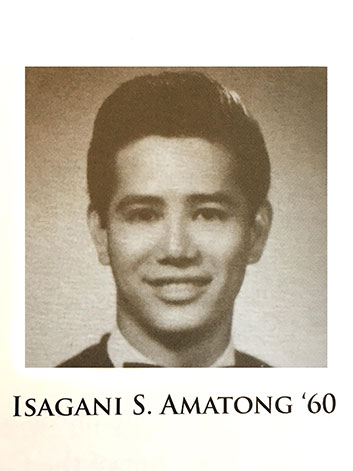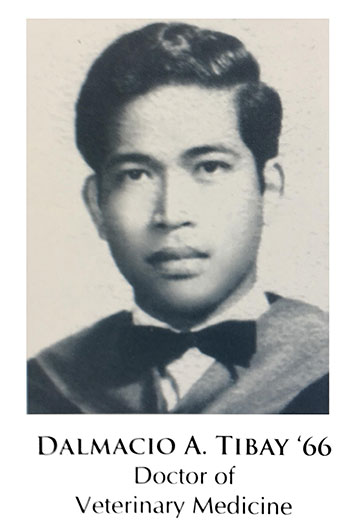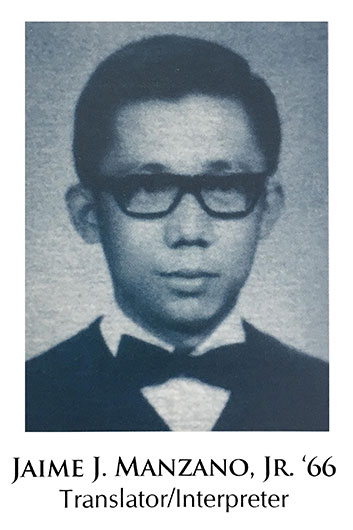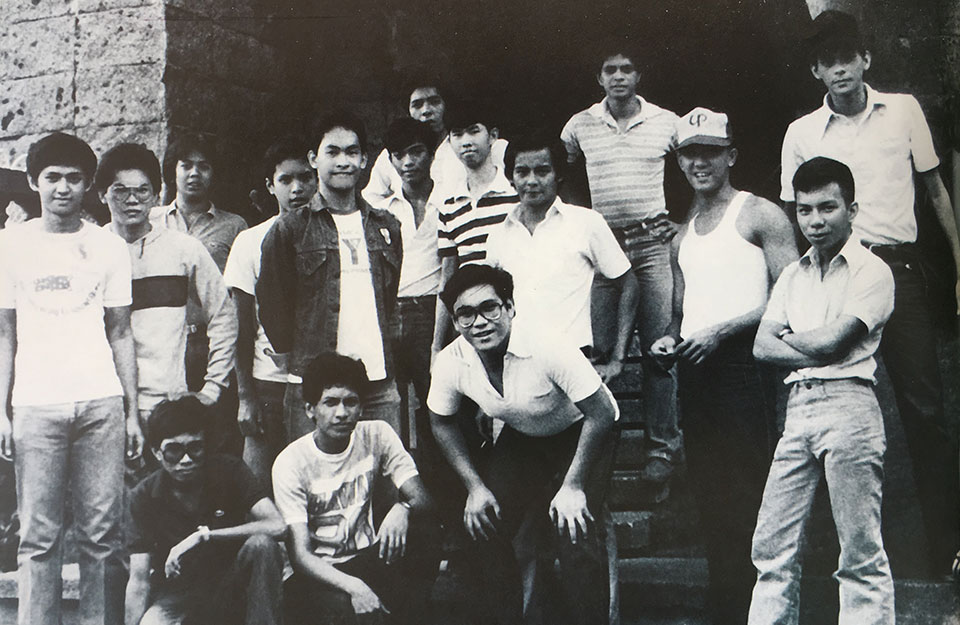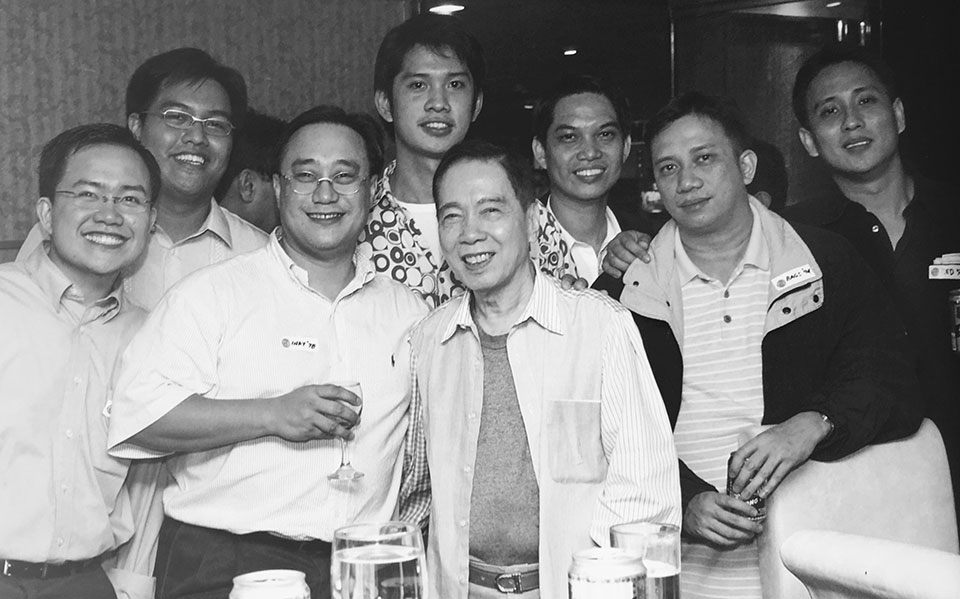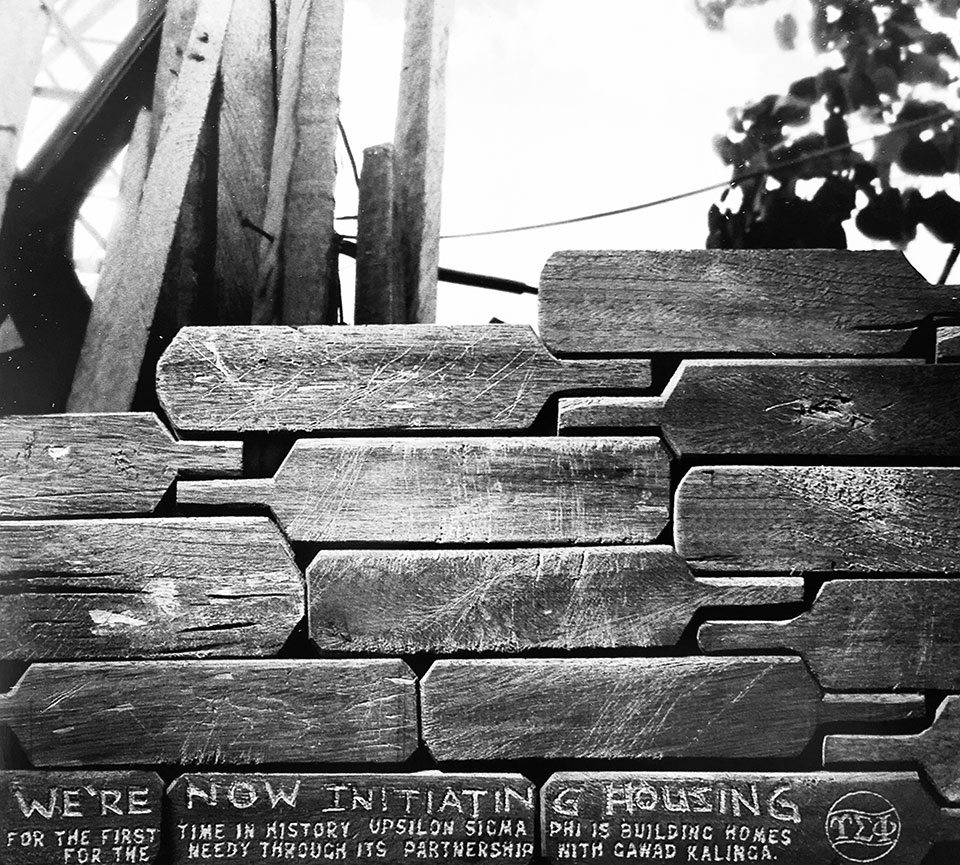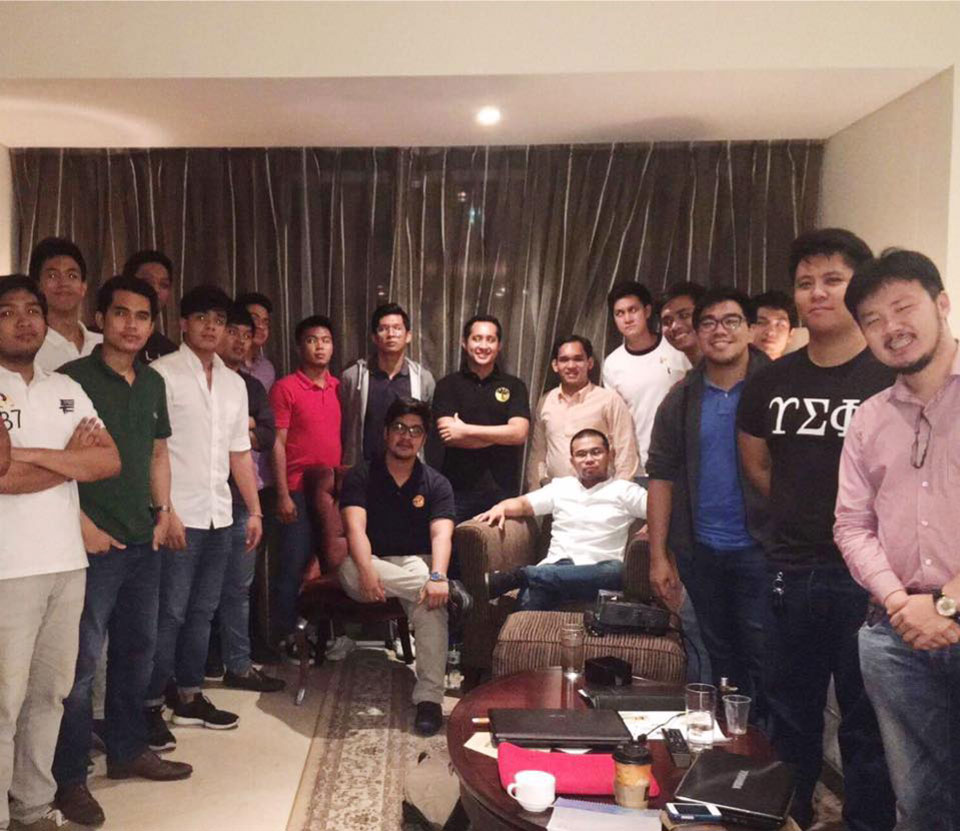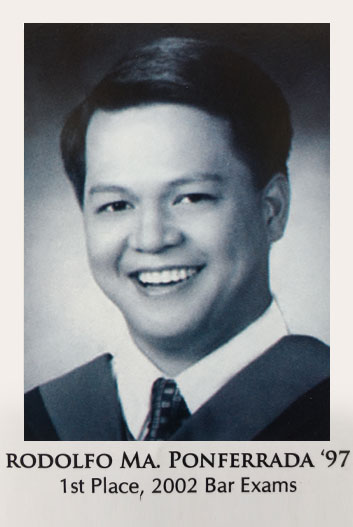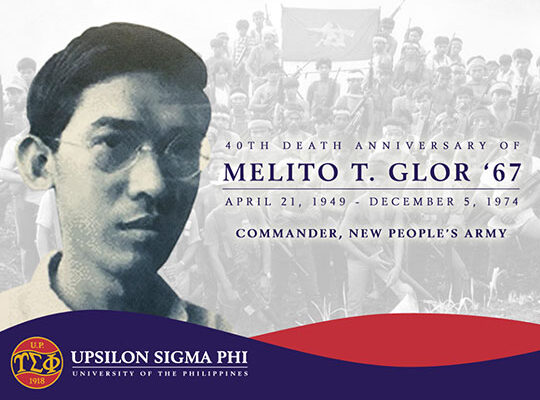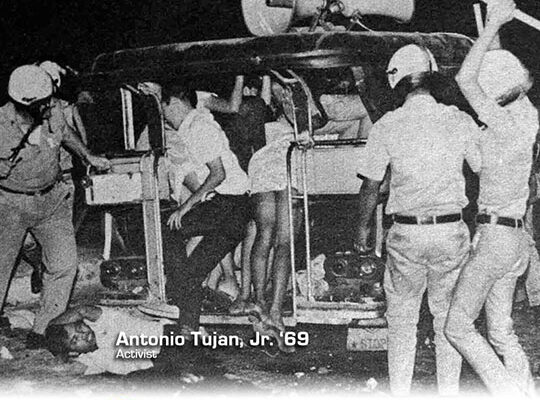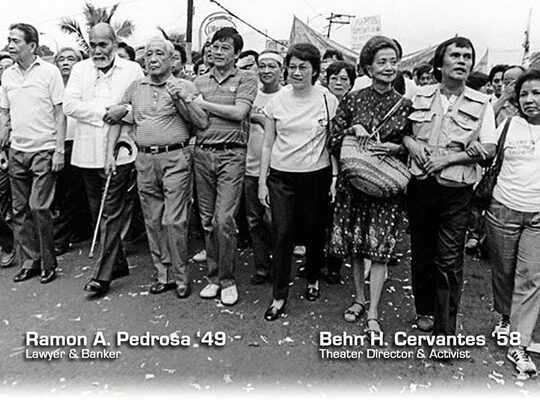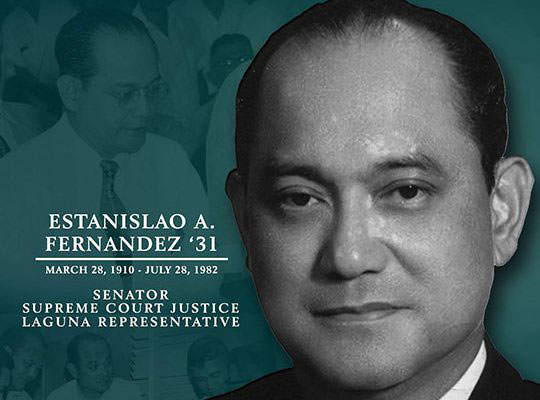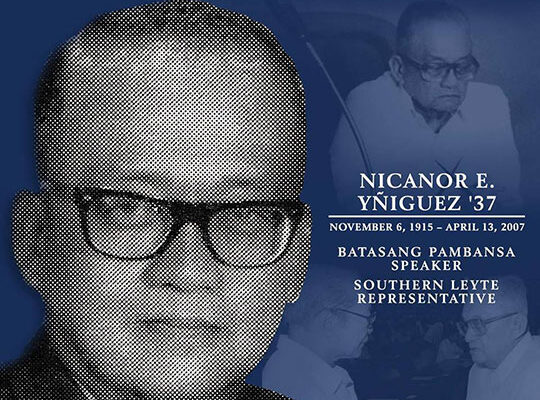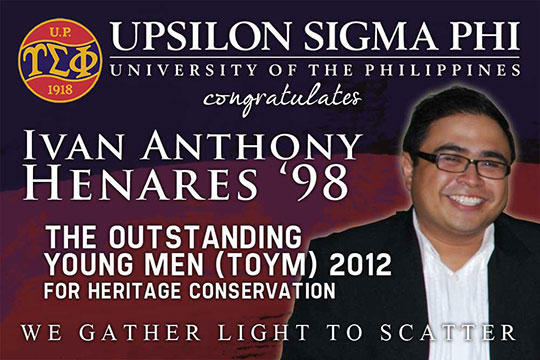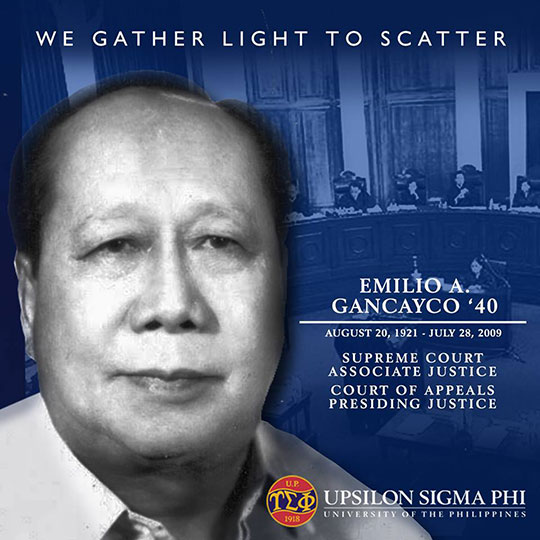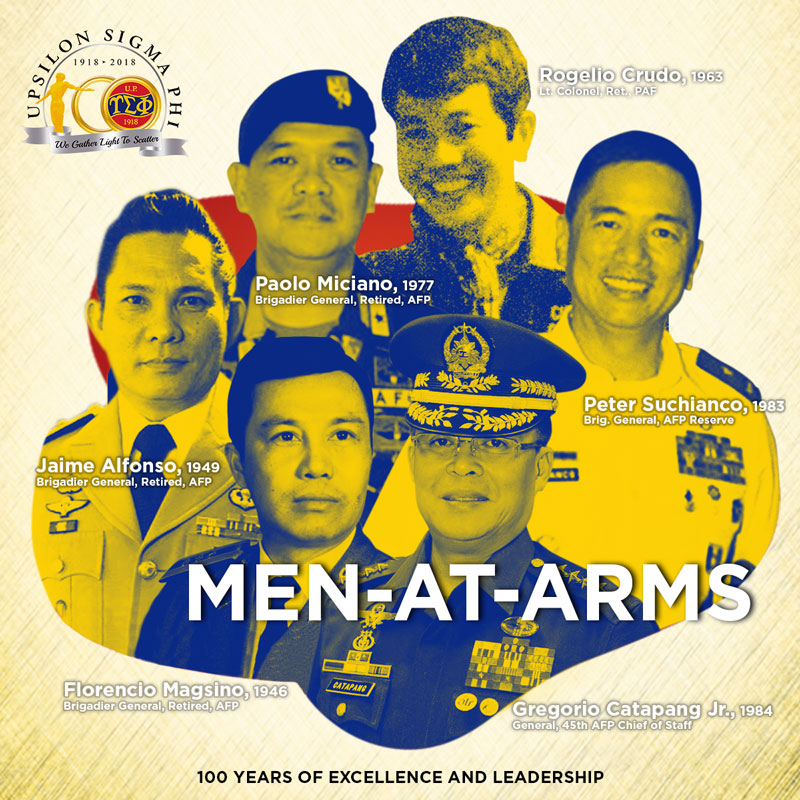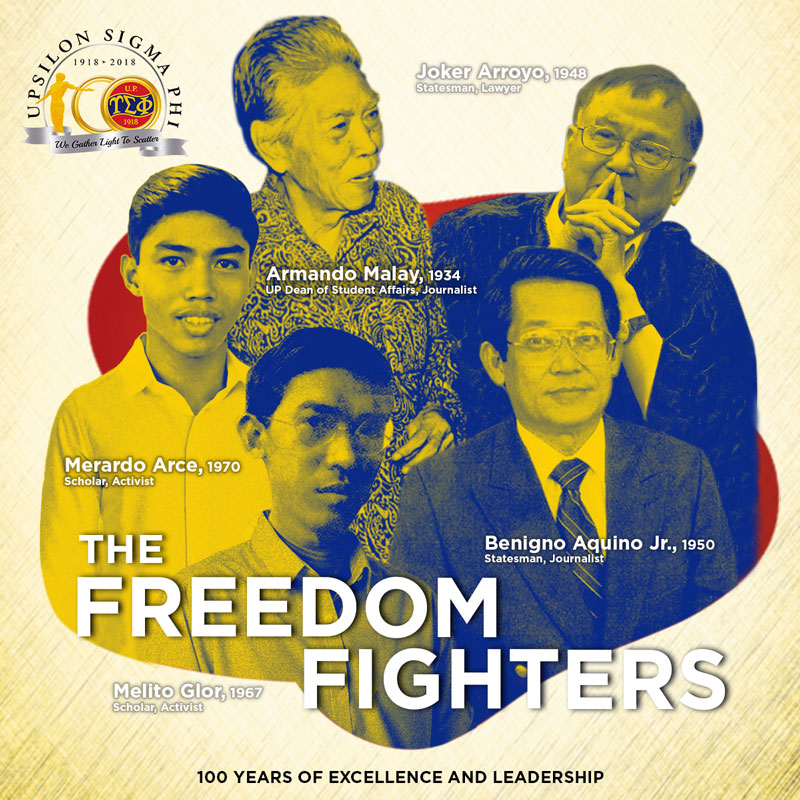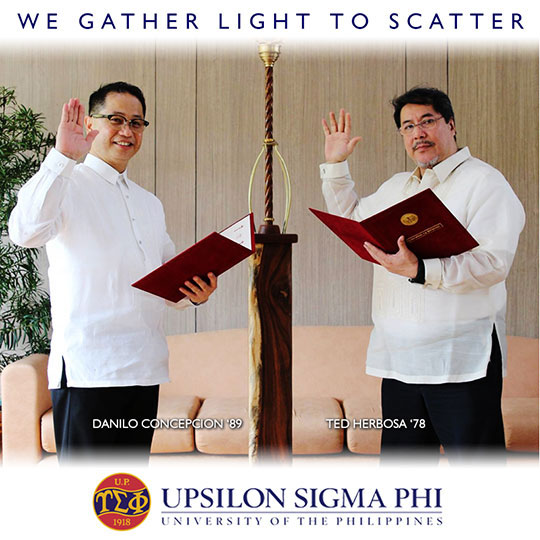

HOW IT ALL STARTED
A UNIVERSITY FOR THE FILIPINO PEOPLE
At the onset of the 20th century, the American colonial government with its vision of a new nation founded in democracy and free enterprise has established the foundations of an educational system that would later give birth to the Univerisity of the Philippines. A state university anchored on its mission of developing Filipino leaders that would eventually shape the nation’s political and bureaucratic structure and lead it towards economic progress.
From its first campuses in Manila and Los Banos, the first colleges of UP has opened its doors to aspiring students of Fine Arts and Agriculture in 1909. In the years that followed, the colleges of Forestry, Medicine and Surgery, Liberal Arts, Engineering and Veterinary Science was established. And in June 1911, the College of Law opened its doors as U.P.’s 7th academic unit.
The UP Campus has continued expanding its academic curricula and it didn’t take long until it became a breeding ground for new thinking, new visions and new mores. It was in this vibrant atmosphere of social freedom that pioneering student organizations emerged, the most illustrious of which is the Philippine’s first fraternity, the Upsilon Sigma Phi.

THE UPSILON SIGMA PHI IS BORN
Founded in 1918 and formally organized in a meeting held at the Metropolitan Restaurant in Intramuros on November 19, 1920, the then-unnamed fraternity elected its first officers: Justiniano Asuncion, Agapito del Rosario, Adolfo Fabella, Sulpicio Bellosillo, Jose Apostol, Kenerino Asuncion, Graciano Rico and Vicente Llamas, all considered founding fathers of the fraternity together with Alfredo Feliciano, Ramon Gandiongco, Aurelio Magat, Jose Mariano, Pablo Sonido and Sancho Zalamea Jr..
On March 24, 1921, the Greek letters Upsilon Sigma Phi (ΥΣΦ) which stands for “University Students Fraternity” was adopted. The rituals which is practiced till present day came from Graciano Rico including its motto: “We Gather Light to Scatter”, its colors: cardinal red and old blue and the fraternity flower: the pink rose.
Early Years 1920s - 1940s
Click on the image to enlarge.
The Upsilon Sigma Phi:
A Storied History of the Fellowship of Light
By Ferdinand Jomilla ’16 and Paolo Gamboa’86
To look into the history of the Upsilon Sigma Phi is to look into the history of the University of the Philippines (UP), and into the Republic of the Philippines, for the development of the three institutions are intertwined in a way that a perspective focused on one absent the others would be nothing short of myopic. However, when all three are taken together, one can then paint a complete picture on the evolution of Philippine society, education, and nationalism.
During the 377 years of Spanish rule, education was limited to only the upper classes of society: the ilustrados. December 10, 1898, upon the conclusion of the Treaty of Paris between Spain and America, the Philippines was thrust into a new war. A war against a former ally, a war of independence, a savage war that would last until 1902 against a new colonial master… America. During this period of early occupation and turbulence, America introduced its own political and educational system leading to the founding of the Philippine Normal School in 1901 and the University of the Philippines in 1908 were higher education was opened to all Filipinos.
Against this backdrop of revolution, evolution and thereafter peace, new ideals came to fore.
In 1918 (twenty years after the transition from Spanish to American colonizers, and ten years into the existence of UP), the Upsilon was sparked into existence by fourteen young men drawn together by the common ideals of leadership and excellence. Thus, came the conceptualization of the Fraternity, with its formal organization coming years later at a meeting held in the Metropolitan Restaurant in Intramuros on November 19, 1920, and the Greek letters “ΥΣΦ (Upsilon Sigma Phi)”—standing for “University Students’ Fraternity”—being adopted as the fraternity’s official name on March 24, 1921.
A Homage to Freemasonry
When defining the roots of the Upsilon, it would be important to recognize its relationship with Freemasonry, from which most of its themes, rites, and rituals are largely based on, the most striking being the use of light as a central theme. According to 100 Words in Masonry, “light” is one of the keywords of Masonry, their motto being “let there be light,” whereas the Upsilon Sigma Phi’s motto crafted by Graciano Q. Rico is “We gather light to scatter,” symbolic of the Upsilonians’ never-ending role of spreading their skills, talents, and services to the world at large. Each being considered a beacon of leadership and excellence. The head of the Upsilon Sigma Phi being known as the Illustrious Fellow.
The Formative and Early Years of Brotherhood
True to its ideals, the Upsilon began as a small gathering of men, the crème de la crème of the UP student body. Invitation was extended by its founders to only to those who possessed the capacity to be leaders, and this showed when Upsilonians such as Ramon Sunico ‘21 (Premier to the Junior House of Representatives), Francisco Tonogbanua ‘24 (Vice President of the UP Student Council 1925-1926), Federico Mangahas ’25 (President, UP Writer’s Club), Jose Gamboa ’29 (ROTC Corp Commander) , Hector Bisnar ’29 (President College Council) and Arturo Garcia ‘29 (UP Board of Regents), started to serve as student leaders in the university. Conrado Benitez ‘21, University Regent was also inducted as an honorary fellow and later wrote the Upsilon Hymn.
During the term of the 4th UP President Rafael Palma which began in 1923, the educational atmosphere in the University was heavily liberal, largely due to the idealism and nationalism of the University President himself. Some critics, however, such as Leopoldo Yabes, wrote then that the liberalism in the university at the time was extensive to a fault, noting that a “wave of immorality” began sweeping the university. Despite the criticism, it was during this then-unprecedented period of academic freedom when Upsilonians began manning the helm and riding the rough waves of early Philippine politics, starting of course, at the university level.
From the decade of the 20’s came forth Jose B. Abad Santos (Chief Justice and Acting President of the Philippines), Carmelino G. Alvendia ‘26(Senior Associate Justice of the Court of Appeals), Jose L. Gamboa ’29 (City Fiscal of Manila), Vicente J. Caedo ’29 (Governor of Batangas), Alfonso Calalang ’21 (3rd Governor of the Central Bank of the Philippines), Teodoro M. Kalaw (Father of the Philippine Library System), Juan R. Liwag ’27 (Senator and Justice Secretary), Pio Pedrosa ‘22 (Finance and Budget Secretary), Antonio R. Quirino ‘26 (Father of Philippine Television), and Agaton Ursua ’28 (Congressman/Camarines Sur, President of the Philippine Dental Association in 1963-65).
The 1930’s, during Palma’s term, was an interesting period in Philippine political history. For instance, the Hare-Hawes-Cutting Act (HHC), enacted in 1933, promised Philippine independence after ten (10) years, on the condition that the United States (US) would reserve several military and naval bases in the country. However, the Act required ratification by the Senate, which did not happen, as it was heavily opposed by prominent public figures, such as Manuel Quezon and Jorge Bocobo, then-Senate President, and the former Dean of the UP College of Law, respectively, due mainly to the condition of reservation of military installations.
The Act, however, gained much support from the UP student body, with Upsilonian Arturo Tolentino ‘31, (who was then Editor-in-Chief of the Philippine Collegian) providing the loudest voice, consistently using his editorial prerogative to staunchly call for the ratification of the Act. This led to a consistent butting of heads between the Tolentino and Quezon-Bocobo camps, especially when Bocobo, citing an old Board of Regents (BOR) rule preventing political articles that provoked discussion in the student publication, stopped the printing of an issue of the Collegian when it published a privilege speech by an undisclosed senator favoring the HHC. It was around this time when UP President Palma publicly took Tolentino’s side against the BOR rule, which dragged not only Palma, but also UP itself, to the conflict, as days after Palma supported Tolentino, the legislature slashed UP’s budget and salaries, which forced the University to increase tuition fees. As it was obvious that Quezon’s ire would not diminish anytime soon, Palma ultimately decided to retire on 1933, but lessons from the Quezon-Bocobo-Tolentino conflict were lessons that UP and the Upsilon would surely not forget. Bocobo would then go on to become the next UP President, while Tolentino would see a future involved heavily in law and public service as congressman and majority leader, twice as Senator (Senate President), as Minister of Foreign Affairs and as Vice President of the Republic of the Philippines.
It was also in this decade, in 1933, that five (5) young women from UP established an organization devoted to excellence in dramatics and fine arts—the Sigma Delta Phi (ΣΔΦ).
The SDP, the sister sorority of the Upsilon, was likewise composed of the UP’s finest stage actresses. In the latter half of the century, SDP would go on to be known as the premiere sorority dedicated to theater, musicals, and stage performances while also taking part in the student activist movements of that era, walking the same path as that of their brothers in the Upsilon Sigma Phi.
From 1933-1939, with Jorge Bocobo manning the Presidency of UP, the University saw a tempering of its previous academic freedom and liberalism under Palma, which was virtually unlimited for the standards of that era. However, despite this tempering under Bocobo’s more “conservative” leadership, the spirit of militancy and student activism in UP did not falter. This decade saw the membership of Ferdinand Marcos ‘37, who was then a student in the College of Law. An esteemed orator at the time, Marcos did not shy away from attacking Quezon’s “frivolity” for holding lavish parties while the country was in a turbulent period, as the Tydings-McDuffie Law was slowly paving the way for the country’s full independence from America. Later in the century, Marcos would find himself at the forefront of one of the nation’s greatest controversies in history which greatly polarized the nation and even the fraternity. Despite the later controversies, however, there is no denying that during the early decades of UP and the Fraternity, he was among those who possessed the quality of leadership and service worthy of the Upsilon name.
Luminaries of the 30’s decade are led by Jose P. Laurel,(4th President of the Republic of the Philippines), Salvador P. Lopez ‘33 (Foreign Secretary and President of the U.P), Pablo R. Roman ’33 (Congressman of Bataan), Querube Makalintal ‘30, (Chief Justice of the Supreme Court, Speaker Batasang Pambansa), Jolly Bugarin ’37 (President Interpol, NBI director), Vicente Ericta ’37 (Justice Tanodbayan), Nicanor Yniguez ’37 (Speaker Interim Batasang Pambansa), Wenceslao Q. Vinzons ‘30 (Congressman, Camarines Sur Governor and Philippine War Hero), Armando D. Malay (Journalist), Domocao A. Alonto ’33 (Senator), Sotero H. Laurel ‘38, (Senator) and Jose B. Laurel ’32 (Speaker of the House of Representatives) to name a few.
When the Second World War (WWII) hit the country in 1939, both UP and the Upsilon were adversely affected. UP had to close most of its colleges, except for Medicine, Pharmacy, and Engineering. As a result, the Fraternity also had to suspend its operations. However, members were still inducted in 1940, 1941, 1942 and 1945. It was in this period, during the Japanese occupation from 1942 to 45. When Wenceslao Vinzons ’30 (former President of the UP Student Council, former editor of the Philippine Collegian, and a graduate of the UP College of law), met his martyrdom at the hands of the Japanese, after a former guerilla turned against him. After being given a chance to pledge allegiance to his captors, he refused instead. Consequently, he was bayoneted to death in Daet, Camarines Norte on July 15, 1942.
After the major interruption brought about by World War II, the Fraternity, which also entered a period of hiatus in 1943 and 1944, was revived through the efforts of Antonio Quirino ‘26 and Jorge Gonzales ’39. In 1947, adjusting to the changes brought about by the war, the Fraternity also established a chapter in UP Los Baños. Like its parent, the UPLB chapter was also the first Greek-letter society in the campus. Unlike the Upsilon, the Rizal Center another organization, could not muster a revival. The Upsilon, however, was able to carry on and pick up right where it left before World War 2, at the forefront of student leadership, politics, and activism.
Prominent members who joined the Fellowship in the 40’s include Joker P. Arroyo ‘48 (Congressman and Senator), Salvador H. Laurel 47 (Prime Minister, Vice President, Senator and Secretary of Foreign Affairs), Onofre Corpuz ’47 (U.P. President), Jose “Pitoy” R. Moreno ’48 (National Artist and Asian Fashion Czar), Gerardo Roxas ’46 (Senator), Estelito Mendoza ’47 (Pampanga Governor and Solicitor General), Camilo D. Quiason ’47 (Associate Justice of the Supreme Court), Mamintal A. B. Tamano ’48 (Senator), Gen. Rene R. Cruz ’49 (Chairman Philippine Olympic Committee) and Romeo M. Escareal ’48 (Justice of the Sandiganbayan).
The end of the decade saw the entry into the Upsilon a student from the College of Law. A virtual unknown in the political landscape at the time, Benigno Aquino Jr. ‘50 already had political aspirations. Little did he know, however, that the coming decades would place him right in the spotlight of one of the thickest chapters in Philippine history with political rival and Fraternity Brother Ferdinand Marcos ‘37. The widely-publicized conflict between the two would also involve various well-known Upsilonians, among which would be Arturo Tolentino ‘31 and Gerardo Roxas Sr. ‘46. But that was yet to happen. As far as Aquino and Marcos were concerned at the time, the former was a journalist and budding Senatorial aspirant, while the latter an incumbent Congressman who would soon win a seat in the Senate, everything was, for the most part, still peaceful in the embrace of fraternal love. Or at least it would be, for the next two decades.
The early years of the Upsilon Sigma Phi spans four decades of building the foundations of the Fraternity, strengthening its roots in the University, revival after World War 2 and thereafter the molding of future leaders of the Philippines.
Men from these decades would find themselves in brotherly agreement and or even disagreement within the halls of power, ultimately defining the destiny of the nation. The accomplishments of these men made the Fellowship of the Light shine ever brighter and stronger that it ensured the survival of the Brotherhood…The Upsilon Sigma Phi.
Click on the image to enlarge.
1950s
Click on the image to enlarge.
The Fifties: A New Stage
By Duncan Vinluan ’17
The decade following the Second World War, a time of revival and reconstruction, ushered in a time when the Upsilon Sigma Phi would enhance the cultural tenor of the university and eventually establish the Fraternity not only as an influential force in the making of the Diliman Campus but also as one of its cultural trailblazers.
Cavalcades
Within the UP Campus, the Upsilon Sigma Phi roared with its Cavalcades (Stage Plays & Musicals). It showcased the Upsilonians’ creative talents as it employed almost all the members of the fraternity; each producing their flair in all areas of stage production — from script-writing, song-composing, acting, to painting, and carpentry.
When the first Cavalcade was produced in 1948, it sowed the seed of an idea that the Fraternity was capable of staging productions. As a result, the Cavalcades were to continue in the fifties and sixties.
The most popular stage production was Aloyan, a musical about an improbable romance between an Igorot princess and a city slicker. Another was Hanako, a comedy-drama musical about a World War 2 veteran and the tribulations his Japanese wife faced in the Philippines. Together, Aloyan and Hanako toured nationwide. Selling at least 50,000 tickets, the net proceeds of which were used to finance the building of the UP Catholic Chapel also known as the Church of the Holy Sacrifice.
Aside from Aloyan and Hanako, the Cavalcades also produced productions of different plots and genres.
One would be Four of the Six, a play inspired by the fact that the usual academic elimination of UP students during the time is four out of six students. I’ll Take Manila contained songs of love for wonderful Manila, from the dirty to its clean parts, and from the poor to rich. Linda was about a girl’s travel to Spain and her romance. Stag ’56 was a spoof on western cowboys, Shakespeare, and ballet.
Interior #14 raised the bar in production. A three-act musical play, it was about the fascination of four provincianos who ventured to the city to try their luck. After a series of unfortunate adventures, a gangster offered them a way out. The play would end with a moral that love is soft only as a feeling; that love is tender, beautiful, and strong.
Lawani was based on a Tagalog legend on the goddess Lawani and a barrio untouched by civilization. The play revolved on a conflict that sprung from the deception of city life that threatened the barrio where the goddess resided.
The Cavalcades endured until 1962 with The Fives that Fell, a musical satire on student life with political overtones on the side.
Aloyan and the Zamora-Martell-Yabut Triumvirate
As Resident Fellow Teodoro “Teddy” Yabut ’49 served as a guerrilla in the mountains of Benguet, he heard the song Laoyan being chanted by the natives. In Igorot folk culture, Laoyan was a legendary Igorot brave who, living with another woman, returned to his wife once he heard his name in tuned in his wife’s song. Fascinated by the story of Laoyan, he collaborated with fellow Upsilonians composer Ricardo Zamora ‘49 and lyricist Manuel Martell ‘47 to write what was said as the first original musical written by Filipinos — Aloyan.
Aloyan was first presented to the public in the UP Theater in Diliman in December 1950. The play was acclaimed on and off the campus and received support from alumni “brods” such as Congressman Ferdinand E. Marcos ‘37, future Senator Atty. Gerardo M. Roxas ‘46, and Congressman Arturo Tolentino ‘31.
In review of the play, Nick Joaquin saw a tradition closer to home. “By going on the road with an original musical that they themselves have written, set to music, directed and produced,” wrote Joaquin, “they are returning, however unconsciously, to the zarzuela stock company traditions of the Ballecers and the Ylagans who wrote, composed, directed, acted in and staged their own productions.”
The cast and crew of Aloyan toured nationwide, putting up delightful shows in numerous cities in the Philippines, including Baguio, Iloilo, Cebu, Legaspi, and Davao. They put up joyous entertainment, sending their audiences home humming the songs of the musical such as “When You’re Away” and “Time Will Tell.”
The success of Aloyan propelled the Zamora-Martell-Yabut triumvirate to write two other musicals for the Upsilon Cavalcade — Hanako and Linda. Linda casted a then aspiring 17 year-old Cebuana who enchanted everybody with her singing and her talent to play the guitar. Her name was Pilita Corrales, whose talents would later make her famous in the Philippines as the “Asia’s Queen of Songs.”
Service to the University
Not only has the Upsilon Sigma Phi marked the fifties with jazz and musicals, the Fraternity has also contributed to a climate conducive to learning in the University through edifices that quite literally asserted the Fraternity’s position in campus geographically.
One can walk in the Diliman campus and see three important structures of the University designed by Upsilonian Cesar H. Concio: Quezon Hall; Melchor Hall; and, the Protestant chapel named Church of the Risen Lord.
The fraternity was also responsible in furnishing the Church of the Holy Sacrifice in 1955. The funds were appropriated from the ticket sales of Aloyan and Hanako.
The Carillon Tower
The magnificent 130-foot Carillon Tower (formerly referred to as the UP Memorial Campanile) was also made through the efforts of the Upsilon Sigma Phi. It was the first of its kind in the Far East, and has withstood different generations in the University.
The Carillon Tower was first conceived in 1940, but the Second World War halted its construction. In 1948, then UP Alumni Association (UPAA) Head and Upsilonian Pio Pedrosa set that the alumni would contribute money for the procurement of the carillon bells. The UPAA created a committee overseeing its fundraising activities, whose membership mainly consisted of Upsilonians — Cesar H. Concio ‘26, Dean Armando Malay ‘34, and Roberto S. Benedicto ‘36.
After the endeavors of the UPAA, the bells were finally installed on July 11, 1952. The Carillon was inaugurated by then President Elpidio Quirino and UP President Vidal Tan on August 1, 1952. At the time, Upsilonian Dean Hermenegildo Reyes headed the UPAA, whose members included other Upsilonians such as Tomas Gan ‘29, Ferdinand Marcos ‘37, and Nicanor Yniguez ‘37.
Music from the Carillon Tower would be heard every morning for the UP students, its faculty and fledgling community. However, age caught up to the Carillon and the bells deteriorated. To save a University symbol, the Fraternity spearheaded the renovation of the bells in 1992.
Today, the Carillon Tower walls bear the seal of the Upsilon Sigma Phi as a recognition of its efforts in preserving a historical landmark. The music from the tower has long gone, but the symbol that the Carillon Tower represents — the enduring service of the University and its students to the development of the country — still remain.
Answering the call of Leadership
In 1955 Cesar Ramos ’57 was elected the Chairman of the UPLB University Student Council. This was the onset for the continued desire of the Upsilon at Los Banos to continuously participate in the student council elections.
The College of Agriculture, the biggest in UPLB became the bastion of Upsilonian leadership with the following as its Dean: Fernando A. Bernardo ’53; Ricardo M. Lantican ’51 (National Scientist); Faustino T. Orillo ’41 (Former Dean of the UPLB, Graduate School); and Ruben L. Villareal ’57 (Former Chancellor).
The 50’s in Los Banos saw the birth of a tradition of leadership that would be bannered on for succeeding years bearing fruit to the assumption of Upsilonians as Deans of various colleges and the penultimate position of Chancellor. To date 5 Fellows have held the highest position of Chancellor at the University of the Philippines in Los Banos.
All throughout the decade Upsilonians acted with zeal, keeping with the times of rebuilding the nation from the ravages of war and destruction.
Many would join the fold during the glory years of light! These include: Josue N. Bellosillo (Justice of the Supreme Court), Serafin D. Quiason Jr. ’50 (Chairman of the National Historical Institute), Edgardo B. Espiritu ’55 (Ambassador); Benigno S. Aquino Jr. ’50 (Senator); Roquito Ablan Jr. ’50 (Congressman); Juanito R. Remulla ’51 (Governor of Cavite); Dionisio Dela Serna ’57 (Deputy Executive Secretary & Chairman of the Pag-Ibig Fund, NHA, HGIC, NHMFC); Jorge L. Araneta ’53 (CEO, Araneta Group of Companies); Christian S. Monsod ’55 (Comelec Chairman); Antonio O. Mabesa ’54 (Theater Actor and Director) Behn H. Cervantes ’58 (Director/Activist), Manuel Rivera ‘57 (Film Director), Kidlat Tahimik ’59 (Artist) to name a few.
Click on the image to enlarge.
1960s
Click on the image to enlarge.
The Rockin’ & Rollin’ Sixties
by Danny Gozo ‘67
Fifteen years after a World War was a time of recovery. Fourteen years as an independent nation was a time to build. By stroke of fate, the young nation by then has gone thru five leadership changes; from Roxas to Quirino, to Magsaysay; to Garcia. In 1962, Diosdado Macapagal, the “poor boy from Lubao” assumed the presidency of the young Republic.
The world was experiencing a different high too. The youngest and first Catholic-born president of the United States, John F. Kennedy has captured the imagination of the young with his eloquence and wit. War-damaged Europe was rising from the ashes and the Cold War was in full swing.
In Asia, China was undergoing a shakeup as the teething problems of governing a billion people has come to roost on the regime of Chairman Mao. In Vietnam, a new war looms as state sponsors change from France to the US in the south.
In Africa, new countries started to spring up like mushrooms from the colonies of fading empires and declining kingdoms.
The world was entering, as the iconic lyrics of a song of the times go ….. “The dawning of the Age of Aquarius!”
In UP, there was a change in leadership too, from the stentorian Vicente Cinco to the amiable intellectual “Dime among Nickels,” Carlos P. Romulo or CPR as we fondly called him. The fact that his immediate past assignment from the government was as PH Ambassador to the US, stymied CPR at first, but soon recovered as he unfolded his vision for the university, starting with a major makeover of all UP campuses nationwide. His vision was to make UP the “best university for the Filipino” and “a center of learning for all of Southeast Asia.”
For the Upsilon, the decade was a mix of highs and lows. Early in the decade were preparations for its Golden Anniversary in 1968. As if to underscore the milestone, the national leadership would change in 1965 to Upsilonian, Ferdinand E. Marcos ’37.
It was said then that the line of succession of leadership of the country was dominated by Upsilonians. The Senate President was Honorary Fellow Gil J. Puyat, the Speaker of the House of Representatives was Jose B. Laurel Jr., and the Chief Justice of the Supreme Court was Enrique Fernando. Upsilonian Senators in that decade would include Arturo Tolentino, Juan Liwag, Mamintal Tamano, Gerardo Roxas, Salvador Laurel and the enigmatic Benigno “Ninoy” Aquino Jr.
It was described as the Golden Age of Upsilonians who answered the call to serve in government in almost all levels, diplomats, military officers, bureaucrats, academics, artists, and even civic leaders.
It was no different in campus. Upsilon had one Student Council President; two Collegian Editors in Chief; Four Philippinensian Editors; Five University Councilors; One College Councilor and several ROTC cadet officers. It was also the decade when Upsilon arts and literary endeavors unfolded, several Jazz Concerts, the plays “Bye Bye Birdie,” “Guys & Dolls” and “Twelve Angry Men” were staged in campus and toured in some provinces.
The sixties brought in the contagious rhythm and melody of the Beatles; the violence and gore of the Vietnam War; the relaxing escapism of “Mary Jane” and the desire to leave the country to study or work abroad, derisively labeled “the Brain Drain”.
Brods and recruits even ventured into forbidden territory when, in 1966, four Upsilonians and four potential recruits crossed the border at Lo Wu bridge to visit what was then labeled as Red China. Teach-ins and discussion groups were in vogue.
One highlight of that period was the successful lobby by the fraternity and eventual transfer of a “Katipunero” statue from its original site in the Balintawak Interchange to the front of Vinzons Hall in Diliman, where it proudly stands today.
The euphoria of the Golden Anniversary masked the creeping alternative offered by the radical left, that of an egalitarian future where no one was supposed to be left behind. The ensuing counter offensive of the new ruling elite was likewise unnoticed, even by the players themselves, who thought they would soon march on to victory. Myopia, it seems was widespread.
In campus as in most cities and countryside, the siren song of a new dawn was literally (and cunningly) allowed to flourish, so that it could be identified and crushed by the so called “New Society” of the next decade.
Fraternity influence was slowly being diminished across academia. Nationalist sentiments, always attractive to young minds was the order of the day. Student activism was starting to worm its way out of its cocoon with the rise of organizations such as the Kabataang Makabayan, the SDK and the national Movement for the Advancement of Nationalism or MAN. And since the man in Malacanang was an Upsilonian, the fraternity was tagged as its ally and student arm. Unbeknownst to many however, within the frat, there were growing too, the roots of progressive thinking that will later yield such names as Mel Glor’67; Med Arce’70; Behn Cervantes’58 etc. On the national stage, Ninoy Aquino’s struggle will later produce legal luminaries like Joker Arroyo’48, Ed Abcede’56 and others in the defense of civil liberties being run roughshod by the juggernaut of the ruling regime.
Romulo’s leadership of UP would be turned over to Upsilonian Salvador P. Lopez’33, a respected diplomat and journalist who would inherit a university at the forefront of a boiling national political cauldron. The Upsilon embarks on its next 50 years.
The sixties were glorious years for the Upsilon. We literally “met with triumph and disaster” and treated “the two impostors, just the same.” We would not trade the experience of being in that decade for anything else.
Click on the image to enlarge.
From Campus to Country: Challenges in the Upsilon Brand of Leadership
By Ed Sunico’86 and Mars Marcelino ’16
The Academe in the Early 60’s
The previous decade didn’t end quietly as series of student unrest in 1957 gave way to what was probably UPs first strike, an action which the Upsilon did not support. This rally of 8000 placard-bearing students gathered in front of the Administration building to force the board of regents to name a new UP president after Vidal Tan’s resignation. The vacancy was finally filled by incumbent College of Law Dean Vicente G. Sinco in 1958, succeeding the able leadership of the interim president and Upsilonian Enrique Virata ’22, who was known for fostering intellectual stimulation by his strong support for individual research. Sinco would later go head on against the heads of the Student Council and the Philippine Collegian which earned for him a reputation of being a strict disciplinarian and even a “dictator”, but also one that unapologetically upholds the rule of law. Eventually, Upsilon’s anti-strike stance would create for itself a negative image of being detached from the sentiment of the student body, an image that would end the fraternity’s “once formidable reign on campus politics”. And it would take another 6 years for an Upsilonian to lead the student council.
In spite of the relatively weaker hold of the Upsilon in campus politics, its accomplishments during the 60’s and early 70s cannot be ignored. The Upsilon has managed to put up three brods as Student Council heads – Eric de Guia ’59, Tristan Catindig’63 and later on Manny Ortega ’66 during the early 70s. It also had three Collegian editors, Tristan Catindig’63, Ancheta Tan’63 and Teodoro Yabut’71. It had dominance over the editorship of the Philippinensian with Ricardo Dino’59, Antonio Hidalgo’60, Honesto Nuqui’63, Pedro Dy-Liacco’65 and Felipe Estella’66 leading the social and political discourse in campus thru its publication.
And of course the Upsilon remained unmatched in setting the cultural atmosphere of UP with its continuous presence in big productions and sponsorships of musical plays and concerts that started in 1955 until 1968. These big and highly complex productions has indeed helped in honing the young Upsilon resident’s skills and instincts which they will later leverage on as they enter the bigger arena of national and industry leadership.
The Romulo Leadership
Sinco’s intensity and constancy in his authority was but the outset from which Romulo’s appointment followed through. For one, he was personally preferred and audaciously appointed by then president Diosdado Macapagal, essentially circumventing the mandate of the Board of Regent to select nominees for and elect the next UP President. Romulo was an honored diplomat serving as our Ambassador to the US. He was a writer and a war hero of his own renowned stature and more than that he was also a visionary – he enacted a beautification project for all contingent campuses of the university as a glimmering proof that his loyalty indeed lies with the Philippines, and not to the west. He even projected his vision of making UP “the best university for the Filipino “and a “center of learning for all of Southeast Asia”.
It’s also noteworthy how, despite initial perception of his staunch defense of American ideals, Romulo supported student demonstrations and organized mobilizations. It’s worth reminding that this is a decade of dissent; complacency across the administration and intervention of external political bodies prompted such radical counter-actions to grow more severe, and Romulo enduring these forces along with the student body was the perfect motion to rise above petty politics in spite of some radical groups that doubted his intent as a mere facade. Around him, the radical movement has already planted its roots, and from its nascent stages, it spread like wildfire, and arguably, Romulo’s administration, one that embraced the university’s “ability and potential for dialogue on themes and issues that are vital to the nation”, helped set this off.
The Ascension of Activism, and the Rise of Pluralism of the Upsilon
When the decade started, the Upsilon was on the side of the anti-sectarian faction, putting it against the more popular UPSCA. This was considered by many as a precursor to the fraternity’s political drought, and so when lines were drawn well into the decade, Upsilon found itself joining the banner of Kalayaan-Lapian Pilipino, the more clement faction which was set against the fervent nationalist faction of the Katipunan-Makabansa that included left-leaning groups.
The fraternity’s political power within the university was evidently dull compared to previous decades and only once do the Upsilon managed to hold the helm of the council during the decade, under the capacity of Tristan Catindig ’63. The term that followed, the Upsilon has only managed to secure a 3 councilor seats: Ramoncito Abad ’66, Richard Gordon ’68 and Manny Ortega ’66 in later years.
It was a completely different scenario however on the national front. The victory and election of Ferdinand Marcos’37 to the highest position in the land in 1965 has pulled up a relatively large number of Upsilonians to serve in top government positions. It was a major victory for the fraternity but also a pyrrhic one for it “led to its eventual marginalization in UP student politics in the 70s and 80s and the polarization of the brotherhood itself”.
Just before the decade of the 60’s ended, the Upsilon would again capture the hearts and minds of the campus when it showed its brand of nationalism by moving the statue of Andres Bonifacio in Balintawak to the UP Vinzon’s Hall. The initiative was part of the fraternity’s celebration of its 50th year anniversary which included motorcades and fellowships in Diliman and Los Banos, one of which was held in Malacanang with no less than President Marcos and First Lady Imelda Marcos acting as host.
In Los Banos, the Upsilon was at the forefront not only in the sciences, but also in the Arts by producing theatre plays and musicals. This has led to a tradition in production where the Upsilon Sigma Phi is known to have produced the most number of Stage Plays and Musicals at the University of the Philippines in Los Banos.
And so, looking back at such an illustrious decade, we are compelled to subscribe to the fraternity’s resiliency, to its pliancy in the face of adversity, to its adherence to the belief that difficulties are to be met by the fellowship’s plurality, where its strength mostly lies. Some things ended, and some things flourished in such a grand manner, but it is the fraternity that remained, bearing with it the promise of longevity when it closed its golden year, looking forward to the next fifty, even beyond.
Luminaries who joined the fellowship in the 60’s include: Richard J. Gordon ’68 (Mayor/Chairman SBMA/Chairman PRC/Senator), Melchor Quitain ’63 (Davao City Administrator), Ben Tabin ’64 (Contractor/Realtor), Isagani Amatong ’60 (Governor/ Congressman), Angelo Y. Castro ‘66 (Broadcast Journalist and Freedom Fighter), Danilo Gozo ’67 (Undersecretary), Francisco B. Aniag ’66 (Congressman), Wencelito T. Andanar ’69 (Governor / DILG Secretary), Alfredo E. Pascual ’67 (President University of the Philippines), Antonio A. Tujan ’69 (Communist Party Secretary General and IBON Foundation Director), Andrew O. Nocon ’60 (Mayor), Guillermo Trinidad ’60(Presidential Spokesperson), Mon Abad ’66 (President of the PNCC), Jess Yabes ’66 (Ambassador), Willy C. Gaa ’66 (Ambassador), Jerome V. Paras’64 (Congressman), Oscar Valenzuela’64 (Ambassador), Menandro P. Galenzogo’63 (Ambassador) and Melito Glor ’67 (Commander, New Peoples Army).
1970s
Click on the image to enlarge.
The Seventies: A Transition
by Noel Ingersol Castro ‘17
Status Quo
The untimely death of Rolando San Luis Perez ’66 during a rumble in September 1969 served as a grim closing of a decade embroiled in dissent. Regardless of the efforts of the Romulo administration to suppress leftist ideas in the University scene, activism still emerged as a prevalent practice and lifestyle in the University of the Philippines upon the proliferation of Marxist-Leninist-Maoist philosophy and the espousing of revolutionary thought in various parts of the country. This outro of the 1960s is what created a pragmatically daunting effect on the Upsilon Sigma Phi, as it challenged the very existence of the fraternity in consideration to what has transpired and what is yet to come. The question of relevance added to the mix, creating an environment that despised elitist fraternities and organizations.
The Upsilon is special and worthy of attention, most notably due to its strong bond with the country’s then-president, Ferdinand Marcos ’37. He loved the fraternity with a love beyond telling. “Sino nga ang maaaring pagkatiwalaan kung di ang mga kapatid sa Upsilon Sigma Phi”, he exclaimed when asked with regards to his chosen partners in governance. Even whenever Marcos set foot on University soil, his Brods were there to accommodate, serving as a closer and more intimate version of presidential security. Even though the Fraternity was all out in support of its President-Brod, being part of the University of the Philippines System established in its members a high sense of honor and excellence, being able to think critically and question status quo when needed. With this, Marcos found political opposition from within the folds of the fellowship he considers home.
It is to be noted that the country was ripe for a new brand of revolution that places the youth at center stage. Students involved themselves in radical communities and groups, some holding the ultimate goal of toppling down the administration. These same people were responsible for the First Quarter Storm, a series of demonstrations and protests condemning the nation’s erratic economy and unbridled imperialism in the first three months of 1970. Protest Actions and Movements became rampant as worker unions and students who boycotted classes organized rallies and demonstrations here and there. Some of them are worth mentioning, such as the demonstration during Marcos’s delivery of his fifth State of the Nation Address in January 26, in which a melee ensued, resulting in at least two dead and many injured, and the January 30 Movement in Mendiola, where protesters were able to secure a firetruck and rammed it into Gate 4 of Malacañang, and where another battle between the military and the student protesters took place.
Role Model in Honor and Excellence
The task of searching for remedies to these events fell in the hands of then-UP President, Salvador P. Lopez ’33. SP Lopez was trained and acclaimed in the art of literature as one of the best Filipino writers in English. It is with this skill that he understood, defined, and deconstructed proletarian literature and achieved a justly supported liberal mindset. Ascending to UP Presidency in 1969, Lopez took on the fight to keep the university and the students alive through the five most chaotic years in UP History. He understood his role in the shaping of young minds, and did all he can in order to protect the interests of the student body, gaining him allies in activism. SP Lopez served as a mediator between the administration and the public, giving the people more freedom from intervention by issuing executive orders that granted “greater autonomy to all student organizations in the handling of funds collected by the University.”
As Upsilonians, SP Lopez and Marcos shared a deep, direct, and amiable connection that prospered despite them being on various ends of the national political spectrum. Dialogue and proper communication was made possible by the sincere fellowship that they shared. It was not until after February 1971 when the connection was tested, when the Diliman Campus was barricaded from the outside world, and classes were boycotted as a form of protest, which later came to be known as the famous Diliman Commune. Violence was a common sight, as police and military attempted to break the barricades and force entry, to no avail. This, along with many other demonstrations resulted in Marcos leading the country to its relatively dark days through his declaration of Martial Law in 1972. When circumstances began to look bleak, SP Lopez served as a beacon that scattered light of hope among the disheartened student population. This noble work is what he continued to accomplish until he stepped down from the UP Presidency in 1974, leaving, aside from the creation of new college programs in applied disciplines and the recognition of Pilipino as a language, the greatest legacy of being a fine example of true activism.
A Brotherhood in Recuperation
The Upsilon Sigma Phi, much like the country and the University, was not deprived of the experience of transition. Being labelled by the dissenting student body as reactionary and as a tool by President Ferdinand Marcos ’37, the Upsilon had a difficult and trying time of rebuilding a weakening culture. Led by Efren Yambot ’60, then Illustrious Fellow, the fraternity was divided as he was politically inclined away from his Senior Brod Marcos ’37. This served as an obstacle for one whose views outright clashed with the fraternity structure. With recruitment being at a standstill and with fraternities being shown in a bad light, Yambot moved to pass the IF role to another tried and true Brod, Jesus Yabes ’66. Yabes was familiar with the ins and outs of leadership, producing Upsilon’s play “Ang Ina”, an adaptation of Bertolt Brecht’s “The Mother” in 1971. The passing of the role would soon prove to be a wise decision, as the Upsilon once again emerges from the darkness, securing a student council presidency through Manny Ortega ’66, and the editorship of the Philippine Collegian through Spike Yabut ’71. Yabes evaluated and studied as to how further he can push the fraternity to ride the waves of transition. He found a way to keep the Brods occupied by initiating projects and plays, such as “Macario Sakay”, and the expansion of the Rolando San Luis Perez Memorial Library at the Upsilon Headquarters in Quezon Boulevard, later moved to Vinzons Hall under the term of Manny Ortega ’66 as Student Council President. With Yabes’s guided discretion, kept the IF role until 1974, passing it on to Delfin Bondad ’68.
Upsilonians would also meet the challenges of leadership in Los Banos where Abelardo G. Samonte ’49 would assume the Chancellorship of UPLB, a first for the fraternity. Fellow Erdie Malveda ’69 would be elected Chairman of the UPLB Student Council and Robert C. Bastillo would be Chairman of the Freshman Block Assembly during the dark days of Martial Law.
Upsilonian Tried and True
Among the many faces in the fraternity, one that forever left an honorable memory was that of Melito Glor ’67. Fondly called “Spooks” by the Brods, Glor was a unique student who believed in a greater sense of self-negation for the greater good of many. Coming from an affluent family in Quezon, Glor enrolled in a Pre-med course in UP and joined the Upsilon in 1967. During his study, he would read political texts and engage in political debates and discussions with leftist groups, neighbors of the fraternity in their apartment along Quezon Avenue. By 1969, he had become radicalized.
Glor eventually joined the New People’s Army and changed from carrying books and displaying his remarkable intelligence, to carrying rifles and brandishing his newfound weapon – a heart filled with bravery and sympathy with the oppressed. He was directly against his senior Brod, President Marcos ’37, but remained militant with conviction. While he was a member of the NPA, Melito Glor would frequent the company of his Brods every now and then, partaking in the fellowship that never fails to make a Brod feel at ease. Glor enjoyed the company despite the drastic changes, both physical and emotional, that the conflict had brought upon him. He would eventually meet up at one of these fellowships with his longtime friend and Fraternity brother, Anthony Bayhon ’64, who became a second lieutenant in the Philippine Constabulary, a precursor of the Philippine National Police. As Chibu Lagman ’63 told, the two Brods shared a fraternal embrace that mirrored a beauty that transcends views, beliefs, and factions.
It would not be until 1974 when the Fraternity receives news that proved to be one of the most heartbreaking – Melito Glor ’67 has died. He was killed in action after an encounter with government troops. Glor displayed an incredible form of conviction by adhering to his beliefs until his death. He left behind a legacy that is forever engrained in the history of the fraternity and the country; Aside from being a symbol of bravery and hope amidst chaos, a major military command was also eventually named after him: the Melito Glor Command. Beside him are Fred Malicay ’64 and Cesar Hicaro ’64, Upsilonians who share the same militant hearts, and who were also killed in a separate incident in Malabon.
Change, in these situations, was the main impetus in the reawakening of the Upsilon Sigma Phi. In retrospect, a barrage of negativity led to transition and rebirth, what the Fraternity experienced in the 1970s. Forged to become stronger were the bonds of steel that kept Brods in close connection despite being separated by mortal political and social constraints. Regardless of which direction they came from, they ultimately possess the same power of gathering and scattering light, further strengthened by adversity. They are Upsilonians, after all. As the song goes: they are “one every time, everywhere.”
Some accomplished and prominent Upsilonians from this decade include: Merardo T. Arce ’70 (Commander, New People’s Army), Mel Sadang ’72 (Justice of the Court of Appeals) Jesus Crispin C. Remulla ’79 (Congressman and Governor of Cavite), Rodolfo O. Reyes ’78 (Governor Philippine Red Cross and former Chairman Cagayan Economic Zone Authority), Rey I. Velasco ’74 (Chancellor UPLB), Rico Puno ’74 (Undersecretary DILG), Paolo Miciano ’77 (AFP General, Special Forces), Jacinto V. Paras ‘71 (Congressman , Negros Oriental), Victor C. Avecilla ’79 (Columnist & Professor), Benjie T. Dimaano ’76 (National Chess Champion), Louis C, Biraogo ’79 (Citizen Barok, Public Interest Advocate), Dr. Teddy Herbosa ’78 (Former Undersecretary, DOH and Executive Vice President of U.P. System) Enrique I. Quaison ’79 (Corporate Secretary, ABS-CBN), Ding Navasero ’70 (Thespian and Actor), Julius Torres ’72 (Ambassador) Jack Arroyo ’74 (Pioneer of eye laser surgery in the Philippines) Johnny Alegre ’79 (World recognized Jazzist) and Dr. Joy Novero ’78 (Invitro Fertilization Pioneer and head at St. Lukes).
1980s
Click on the image to enlarge.
Upsilon in the 80s. Excellence in the Midst of Revolution
by Alan Austriaco ‘86 and Viktor Austria ’17
“It was the best of times, it was the worst of times….. It was the season of Light, it was the season of Darkness; it was the spring of hope, it was the winter of despair…”
Dickens might as well have been referring to the Philippines in the 1980s when he penned those words.
Ninoy, Marcos and EDSA
The 80s were tumultuous times. In 1983, Senator Benigno Aquino Jr ’50 was coming home after his 3-year exile in the United States. He was under surveillance and at that time had no Philippine Passport. To facilitate his return, he was given a new passport by former Ambassador Joey Ampeso ’68 bearing the name Marcial Bonifacio. While en route to the Philippines, Doy Laurel ’47 gathered the opposition and Upsilonians to await his arrival at the Manila International Airport. Upon his planes touchdown in Manila, he was taken by security elements and was assassinated in the tarmac of the Manila International Airport. What followed was a massive public outcry that culminated in one of the longest funeral processions in the country’s history, with more than two million people lining the streets and Aquino’s hearse winding through Metro Manila for 12 hours. Ninoy’s assassination transformed a fledgling opposition into a national movement. Director Behn Cervantes ’58, prominent opposition activist, would lead other Upsilonians in the daily street protests that ultimately served as the impetus for a victorious revolution 3 years later.
The 80s were triumphant times. In 1986, under pressure from the US, President Ferdinand Marcos ‘37 declared a snap Presidential election to silence the protests and criticisms directed at his government. The fraternity figured very prominently in this exercise, with Fellows Salvador Laurel ’47 and Arturo Tolentino ’31 contesting the Vice-Presidency, and challenging the incumbent President was the widow of Ninoy ’50, Corazon Aquino. After a heated electoral process, the COMELEC declared Marcos as the winner, garnering 1.5 million votes more than his closest adversary, Aquino. Protests discrediting the elections were held daily, particularly when the NAMFREL declared Aquino as the rightful victor, with 500,000 more votes than the incumbent. Mounting calls for Marcos to step down culminated in the peaceful EDSA People Power Revolution. Dubbed the ‘revolution that surprised the world’, the EDSA Revolt inspired a call for change through peaceful means instead of bloodshed. Its effect was felt worldwide, prompting CBS anchor Bob Simon to comment, “We Americans like to think we taught Filipinos democracy. Well, tonight, they are teaching the world.”
As Marcos ’37 was abandoned by his political allies and went into exile in Hawaii, Upsilonians would continue to visit him. Guillermo “Gemmo” Trinidad ’60 would become his spokesperson and stay with him all throughout. Such samples of dedication and fellowship among Upsilonians, between Senior and Junior Fellows, no matter the hardship, remain to this day.
On the other side of the political fence, Doy Laurel ’47 assumed the concurrent positions of Vice President and Foreign Minister, Danilo Gozo ’67 would become Undersecretary of the Office of the Press Secretary and Mon Abad ’66 as President of the PNCC. Many others would serve in various leadership roles in the freedom government of President Corazon Aquino and the revitalized Local Government Units.
Angara, Abueva and the UP.
The University of the Philippines in the 1980s mirrored the state of flux that existed in the country during that time. In 1981, the appointment of Edgardo Angara as UP President was met with confusion, as a relative unknown was voted unanimously by the Board of Regents to head the State University. More of an administrator than an educator, Angara’s term was highlighted by improvements in the school’s infrastructure, with repairs done in the Philippine General Hospital, the Law Center Complex and the College of Arts and Sciences (which was split into the College of Science, College of Social Sciences and College of Arts and Letters, also during his term,) as well as the construction of the UP BLISS, which offered low cost housing to UP teaching staff. His vision to make the University self-sufficient led to a move to increase tuition fees which was questioned and challenged by then law students Louie Biraogo ’79 and Victor Avecilla ’79 in the Supreme Court. This situation did not sit well with the students and resulted in a furious string of protests and rallies against Angara resulting in the current socialized tuition fee system in UP.
What would follow Angara’s visions of fiscal autonomy would be political scientist Jose Abueva’s vision of “learning and leadership for social transformation”. Abueva’s overarching theme of strengthening the leadership capacity within the university would manifest in projects such the establishment of the Center for Leadership, Citizenship, and Democracy (CLCD); the creation of the Center for Women’s Studies and the Sentro ng Wikang Filipino (now known as Komisyon ng Wikang Filipino), the adoption of Filipino as the lingua franca in bachelor courses, and, perhaps the most remarkable by all who have donned it today, the introduction of the “sablay”, the long cloth that drapes the shoulders and chest of the finishers, effectively escorting the old toga design out the door.
Despite such significant projects coming into fruition, Abueva would still echo Angara’s vision of fiscal autonomy, as evidenced by the implementation of the controversial Socialized Tuition and Financial Assistance Program, the nascent phases of today’s STS, then still known as the Iskolar ng Bayan program, a matriculation scheme which essentially systematizes tuition fee increase of almost 170% percent. Simply speaking, it socialized the tuition system into brackets, where richer students pay more and poorer students pay less, with the possibility even of getting stipends and subsidies.
It certainly didn’t help that Abueva’s administration was hostile to dialogues with camps who registered dissent. He would ignore their pleas, shrug off voices of oppositions, and shut out baulking students, earning him the ire of his constituents who deemed him “arrogant” and “standoffish”. During this whole time, Bob Guinto ’86 would be sitting as Managing Editor of the Philippine Collegian and assure that the students’ voices were heard. Abueva would later on step down in 1993, carrying in his departure a legacy of what would seem promising projects, marred by his poor relationship with the rest of the students.
Politics, Palace-ingan and the Brods.
For the Upsilonians in the 80s, amidst the ‘sea of change’ occurring in the country and the University, much remained the same. That is, the brods carried on the Fraternity’s tradition of leadership and excellence, both in and out of the campus.
In 1986, Francis Pangilinan ’81 won the Chairmanship of the University Student Council (USC), as the Fraternity proved its mettle as one of the most efficient and well-oiled political machines the University has ever seen. Cochise Bernabe ’81 and Isko Catibayan ’85 were among the top vote-getters when they won as USC Councilors in 1984 and 1988 respectively. In the different colleges, the brods also showed their dominance, as Carlo Ocampo ’85 led the School of Economics Student Council, Bingo Soriano ’84 won as Chairman of the College of Business Administration Student Council, Gerry Panga’86 led the Asian Institute of Tourism and Raffy Santos ’85 represented the College of Architecture in the USC. Campus organizations also benefitted from the brods’ leadership prowess, as showcased by Anthony Pangilinan ’83, who, after serving as President of AIESEC-UP, became the first Filipino to serve as President of AIESEC International.
In Los Baños, the 1980s saw a resurgence of the Fraternity’s University and Campus Leadership. Andrei Tuazon ’82 assumed the Chairmanship of the UPLB University Student Council. In 1985, student leader and activist Bong Manlulu ’85 was elected Chairman of the Freshman Block Assembly. 2 years later, Manlulu would miraculously survive after being shot while taking part in the infamous Mendiola Massacre. The 80s would also witness the birth of the Upsilon Sigma Phi Los Baños Alumni Association, as it was formally organized and registered with the SEC.
As far as campus activities were concerned, Upsilon Sigma Phi remained at the forefront. Through the efforts of IF Boying Remulla ’79, it was in 1985 that the fraternity ambitiously launched a revival of the cavalcades with the staging of “Lakhang Akda” and “Kaibigan”, music by Gabby Malvar ’85 and respectively featuring Francis Pangilinan ’81 and Vladi Platon ’81 in leading roles. 1988 saw the birth of “Palace-ingan”, the country’s first ‘beer-all-you-can’ party, held at the Coconut Palace. In 1989, IF Bobby Liamzon ’84 would spearhead the production of the biggest concert on campus, “Sa UP nAPO Sila”, featuring the Apo Hiking Society. Not to be outdone, the brods in Los Baños won First Place in the University-wide songwriting and interpreting competition, “Himigsikan”.
Despite all the positive circumstances enjoyed by the Upsilon, the 80s wasn’t all sunshine and rainbows. The success that the Fraternity enjoyed in both the political and cultural arena bred resentment among other fraternities. Rumbles were a sad reality in the life of an Upsilonian in the 80s. Violent confrontations between the Upsilon and other fraternities reached such unthinkable heights that left the University a virtual warzone. During the hotly contested USC elections of 1987, the so-called “Frat Alliance”, composed of ten other Greek-letter organizations, attacked Upsilonians as they were meeting at the AS parking lot. Only the timely intervention of some intrepid Fellows prevented the AS area from becoming a battlefield.
The passage of time saw the Upsilonians of the 80s persevere and ultimately succeed in carving out a name in Philippine society. Among them are Senator Francis Pangilinan ’81, GSIS Board Director and Vice President’s Chief of Staff Jesse Andres ’81, Palawan Vice Governor Dennis Socrates ’82, NASA Scientist Johnson Apacible ’82, Makati Development Corporation President Dan Abando ‘82, Roxas Congressman Dinggoy Roxas ’83, Tarlac Governor Victor Yap ’84, AFP Chief of Staff Gregorio Catapang ’84, PBA Commissioner Chito Salud ’84, UPLB Chancellor Dindo Sanchez ’84, Leyte Congressman Martin Romualdez ’85, Pasig Congressman Roman Romulo ’86, Assistant Solicitor General Eric Panga ’86, Laguna Board Member and Dep Sec Gen Philippine Red Cross Neil Nocon ’87, Cavite Governor Jonvic Remulla ’87, Pampanga Congressman Rimpy Bondoc ’87, Philippine Ambassador to Russia Carlos Sorreta ’88, Cavite Congressman Gilbert Remulla ’89, UP President Danilo Concepcion ’89 and International Tenor Lemuel Cuento ’89 among others.
True to its motto of “scattering the light”, the 80s Upsilonian has carried the torch passed on by his predecessors and has lit the path for the generations of Upsilonians to come.
1990s and the New Millennium
Click on the image to enlarge.
The Nineties and Beyond: The Upsilon Sigma Phi Lives On
By Eike Bolinao ‘16
Upsilon in the Nineties
The dawn of the new millennium ushered in new challenges for the fraternity inside and outside of the university. It started with a tragedy on the night of April 25, 1990 when Cochise Bernabe ’81 and his girlfriend were abducted and later on brutally murdered. The perpetrator would later on be pardoned in 2014 from his life sentence after serving 24 years in prison. This would be the first of 2 brutal killings of Upsilonians that would haunt the fraternity in the 90’s.
On a national scale, there was a call for stability and order as the country was rebuilding post EDSA I. The clash of ideologies was present as the post-EDSA government experienced hurdle after hurdle. The supporters of the previous administration remained fervent in their cause and expressed their continued opposition. The Ramos Administration ushered in a spirit of unity and service to country and saw many Upsilonians like Mon Abad ’66, Richard Gordon ’68, Dion Dela Serna ’57, and Salvador Laurel ’47 becoming prominent Upsilonian national leaders during this decade. Several more were Senators, Congressmen and local elected officials.
Ultimately the nation desired leaders to guide its citizens to a united front owing in part to the global Philippine centennial celebrations where unity was the guiding mantra. The Philippines was on its way to becoming a tiger economy! There was a search for a new brand of leadership from important institutions like the University of the Philippines. Technology took the spotlight. This required people to be savvy in order to utilize these new advancements to their favor.
UP students put a premium on getting the UP diploma that would lead to a future stable job. The path to graduating with honors, however, was not clear. With the rise of business industry, bars and restaurants sprouted here and there. The temptations of an active social life become more apparent than ever.
Revolving around this context, the Upsilon Sigma Phi adapted to the changing times but remained true to its roots – the doctrines and traditions which molded all Upsilonians from the past to the present to excel in their chosen fields.
The fraternity advocated a balance between social and academic lives. This marked the start of monitoring of the academic performances of Upsilonians in all of their classes. This practice, started in the nineties persists today, ensuring that Upsilonians were fulfilling their duties as UP students. Various academic feats were achieved such as topping the various board examinations in Landscape Architecture, Engineering, and the Bar Examinations.
On the educational front, the era started on a high note with Ruben L. Villareal ’57 assuming the Chancellorship of UPLB in 1993. In the mid-ninetees, Norman Bordadora ’92 assumed the position of News Editor of the Philippine Collegian starting his journalism career in the university, and eventually becoming Senior Editor in GMA News Online.
In Los Banos in 1990, under the leadership of IF Neil Nocon ’87, the fraternity would initiate the holding of several international symposia on international relations where the Russian and US Ambassadors would be in attendance. Not only were these a first for the fraternity, but also a first for UPLB being the venue for discourse of this kind.
Starting with IF Geboy Duldulao ’88 and continued by IF Troy Banez ’86 a relative peace occurred in the University where altercations with other Fraternities were reduced due to the establishment of communications between Heads and Officers and the Upsilon Resident Leadership. This resulted in higher membership, with more joining the fold. Meanwhile, in Los Banos, IF Keats Yaptiongco ’87 and the Fraternity had to contend with the brutal kidnap slaying of Alan Gomez ’90 and Sigma Deltan Eileen Sarmenta. The Sarmenta –Gomez case would become a rallying call that united both alumni and the resident chapters against a plot to exonerate the perpetrators. United, the fraternity saw the case to its challenging end until the Supreme Court affirmed with finality the judgment of 7 life terms of 40 years each for the heinous crime. This further elevated the fraternity in the eyes of the public for its dogged pursuit of justice.
In the latter part of the era, the Upsilon started its return to the political arena of the UP, winning key positions in the University Student Council and local college councils like College of Social Sciences and Philosophy, Engineering, Arts and Letters and Law. In UP Manila, the fraternity showcased its dominance in the University Student Council as well, all under the terms of Illustrious Fellows Marco Lagdameo ’87, Roy Corpuz Jr. ’89 and Deo Custodio ’91.
The nineties offered a busy schedule for the Upsilonian. Outside the university, Katipunan Avenue, Capitol Hills and Makati developed into venues for fellowship. Likewise as tradition, Upsilonians graciously hosted gatherings in their homes as well. When celebrations could not wait, the parking lot tambayan became the scene for joy and laughter. Indeed, the fellowship remained constant.
Upsilon Month became an annual attraction for the whole university as the fraternity had a month-long celebration of its anniversary every November. These were highlighted by numerous events which benefited all sectors of UP. Some events during this decade were: the traditional Day of Roses (giving out pink roses to all the women in campus while Upsilonians serenaded them with songs); Alay sa Manggagawa sa UP (for the rank and file UP employees); Dakdakan (slam dunk contest with cash prize) and a culminating party.
The death of a neophyte of a fraternity in another Law School in 1991 led to the enactment of Republic Act 8049, widely-known as the Anti-Hazing Law. The Upsilon Sigma Phi took it upon itself to implement policy changes to ensure its compliance with the law. The USPAA Board became an important figure in the observance of the new protocols for entry into the fellowship. Roughly 400 fellows from 1990 to 1999, in both the Diliman and Los Banos campuses, embraced the Upsilon fellowship during this decade.
The nineties ushered in a new age of Upsilonians who have shared struggles and a vision of an Upsilon that continues to stand the test of time. Truly, the fellows of the nineties have contributed to the emergence of new leaders of the fraternity as its young alumni, leading the resident brods of the Upsilon towards the new millennium.
The prominent Upsilonians of this generation are Raul Paras ’90, Louie Pawid ’90, Danger Sanchez ’91, Mike Sandejas ’91, Lawin Bulatao ’91, Blas Viterbo ’91, Jorenz Tanada ’92, Noel Puyat ’92, Norman Bordadora ’92, Mark Guttierez ’92, Babes Calixto ’92, William Fuentebella ’93, Mikko Palarca ’93, Arnie Fuentebella ’94, Chet Tan ’94, Carlo Vistan ’94, Joseph Angeles ’95, Emil Liwanag ’96, Karlo Tugaff ’96, Pong Ponferrada ’97, Rey Vivo ’97, Ivan Henares ’98, Nicky Ty ’99 and Jat Caringal ’99 to name a few.
The New Millennium
The 2000’s is characterized by the dominance of the Upsilon in student politics and university leadership. As years went by, the fraternity continued to be at the forefront of campus leadership in the UP system. This included the assumption into office of Fellow Luis Rey I. Velasco ’74 as Chancellor of UPLB 2005 and thereafter towards the end of the decade by Fernando C. Sanchez ’84 in 2010.
The fraternity co-founded the Progressive Students’ Party (PRO-STUDENT) in 1999 to provide the Upsilonians with the necessary machinery needed for the University Student Council elections. The fraternity triumphed as incumbent members of the student councils were embraced into our sacred fold. With this, the Upsilon moved forward with another party it co-founded, ALYANSA. And later on, a new political party was also co-founded by the Upsilon, and it was KAISA.
With the help of the credibility and performance of Upsilonian student leaders during this time, more victories came for the fraternity in the field of campus politics. The beauty of the Upsilon is in its diversity. Brods were members of different political parties but at the end of the day, they were bound by the ideals and imperatives of the fraternity.
The field of athletics also featured Upsilonians who represented the university and the nation seeing Upsilonians competing in the Olympics, the Southeast Asian University Games and the University Athletic Association of the Philippines (UAAP) in swimming and fencing to name a few.
The fraternity exerted efforts in entering the Philippine Collegian once again after more than three decades seeing Upsilonians holding both editorial and management positions within the vaunted university publication. In Los Banos Erwin Escubio ‘02 would be appointed Editor-in-Chief of the UPLB Perspective and within the same decade followed by Sam Pasia ’05 likewise as Editor-in –Chief of the primary UPLB campus publication.
In preparation for national leadership, the fraternity became involved in service initiatives for alleviating poverty and reaching out to minorities. Partnerships were made with Gawad Kalinga (GK) and Mission: Katutubo Village. Several Upsilonians were key in the involvement of the university with the national projects of the GK which aimed to provide homes for the poor. Meanwhile, Mission Katutubo directed its efforts in serving the Aytas of Porac Pampanga. These initiatives strengthened further the character building efforts of the fraternity.
Whether inside or outside of the university, the Upsilonian shines brighter than any other individual, casting its light upon all citizens of the nation. The Upsilonians of the new millennium continue to share the vision and objectives of the founding fathers back in 1918. They remain steadfast in their unending work of gathering light to scatter.
The prominent brods of this generation include Kris Ablan ’00, Quincy Allado ’00, Paolo Mapula ’02, Timmy Chua ’02, Third Bagro ’02, Benjo Delarmente ’05, Lester Yupingkun ’07, Ibarra Guballa ’08, JC Tejano ’09, Sean Aquilino ’09, Aaron Letaba ’10, Noel Bernardo ’11, JP Delas Nieves ’13, Rai Velasco ’14, Gab Mejia ’16, and Yael Toribio ’16 to name some.
As the fraternity marks its centennial celebration, it can proudly boast that the Upsilon Sigma Phi, the oldest Greek letter fraternity in Asia is here, is an active element in the shaping Philippine leadership and its society and will continue to do so in the future. The Upsilon Sigma Phi remains a bastion of excellence and leadership that continues to define the destiny of the nation.
Click on the image to enlarge.

UPSILON AND THE NATION
Upsilon and the Nation is a collection of Upsilon Sigma Phi Fellows who have played pivotal roles in the history of the Philippines.
Featured here are Upsilonian heroes from different periods of history.
Upsilonians who lead different political parties, in the administration and opposition, resulting in economic stability and political maturity of the Republic.
Upsilonians who have been honored at the Bantayog ng mga Bayani, fighting for social justice, democracy and freedom.

CELEBRATING EXCELLENCE
Celebrating Excellence is a collection of Upsilon Sigma Phi Fellows who have received the utmost recognition for excelling in their chosen fields.
Featured are Upsilonians who have been awarded Philippine National Orders, Military Decorations, International Awards and National Awards.
Featured here as well are Upsilon Sigma Phi Fellows who excel in Arts, Music and Culture, Business Administration and Economics, Education, Government and Public Service, Law, Medicine and Health, and Science and Technology.
100 YEARS OF EXCELLENCE AND LEADERSHIP
In 1918, our founders put forth ideals that the Upsilon Sigma Phi has pursued since – a climate of learning and progress in our Alma Mater, political maturity and economic stability in our Republic, and ultimately, transforming the world for the better. It is in this pursuit, that the Fellows presented here rose to prominence in their different fields and endeavors, and produced Upsilon Sigma Phi’s 100 Years of Excellence and Leadership.
THE ARTIST ADVOCATES

These artists gave voices to those seeking freedom from oppression, marginalized indigenous cultures, precious natural places needing protection, and various advocacies through their art.
They are Upsilonians.

He was a tried and true Upsilonian.

He is a tried and true Upsilonian.

He is a tried and true Upsilonian.

He is a tried and true Upsilonian.
UNIVERSITY PRESIDENTS

In the Upsilon Sigma Phi’s pursuit of our Credo’s dictum ‘to create a climate conducive to learning and progress in the University of the Philippines’, these four Fellows have served in our Alma Mater’s highest office.
They are Upsilonians.

He was a tried and true Upsilonian.

He was a tried and true Upsilonian.
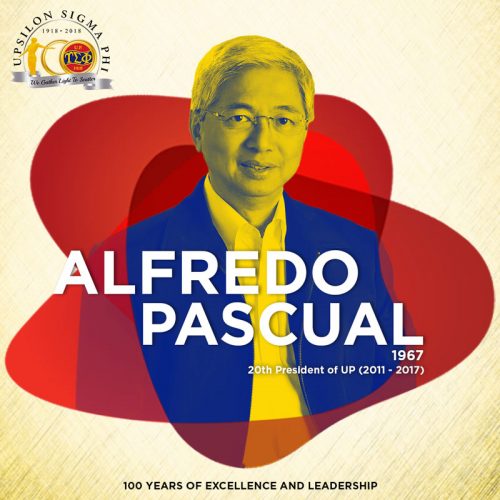
He is a tried and true Upsilonian.
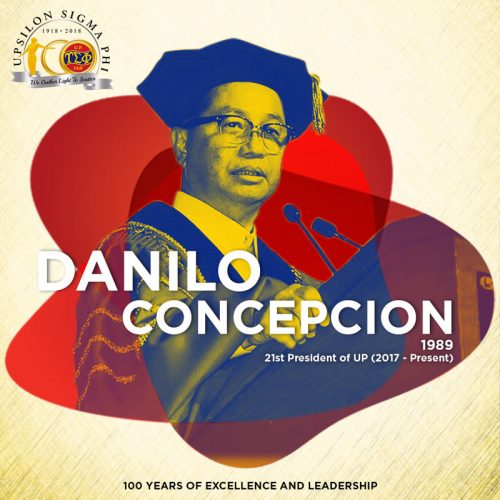
He is a tried and true Upsilonian.
MEN OF SCIENCE

The Upsilon Sigma Phi pursues excellence and leadership in all fields. The scientists presented here sought a better world for all by furthering knowledge and its application in their respective disciplines.
They are Upsilonians.
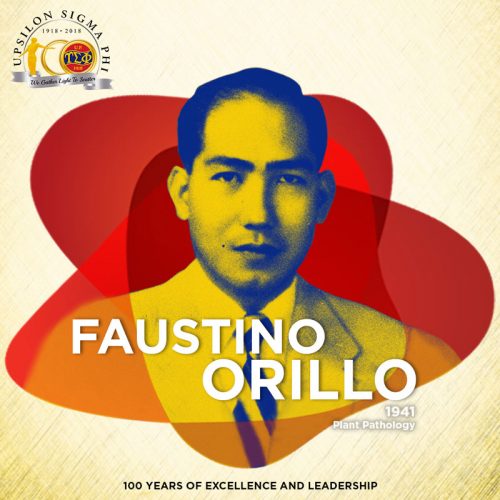
He is a tried and true Upsilonian.

He is a tried and true Upsilonian.

He is a tried and true Upsilonian.

He is a tried and true Upsilonian.

He is a tried and true Upsilonian.

He is a tried and true Upsilonian.
THE PHYSICIANS
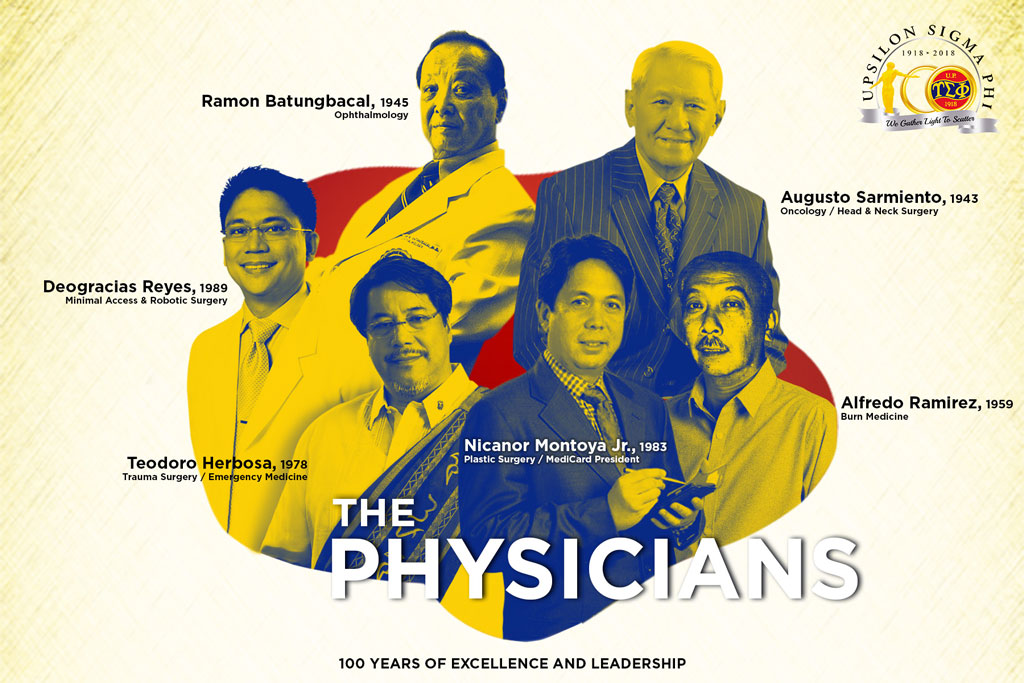
By rendering exemplary service through medical practice, research, education, policy, administration and insurance, the Fellows described here have collectively alleviated the plight, saved, and given hope to countless lives of our fellowmen.
They are Upsilonians.

He is a tried and true Upsilonian.

He is a tried and true Upsilonian.

He is a tried and true Upsilonian.

He is a tried and true Upsilonian.

He is a tried and true Upsilonian.

He is a tried and true Upsilonian.
THE INDUSTRIALISTS

These Fellows harnessed personnel and materiel to a visionary leadership thereby driving their organizations to the forefront of their respective industries.
They are Upsilonians.

He is a tried and true Upsilonian.

He is a tried and true Upsilonian.

He is a tried and true Upsilonian.

He is a tried and true Upsilonian.

He is a tried and true Upsilonian.

He is a tried and true Upsilonian.
MEN-AT-ARMS

They are Upsilonians.
THE ENVIRONMENTALISTS

They are Upsilonians.
THE FREEDOM FIGHTERS

They are Upsilonians.
UPSILON AND THE UNIVERSITY
Upsilon and the University is a collection of Upsilon Sigma Phi Fellows who have contributed to creating a climate conducive to learning and progress in the University of the Philippines.
Featured here are Upsilonians who are part of the University of the Philippines’ Administration, Faculty and distinguished Alumni. Featured here as well are Upsilonians who are Student Council, Student awardees, Honor graduates, Topnotchers and Varsity athletes.
REFERENCES
References
Nemenzo, Gemma R. We Gather Light to Scatter: Ninety Years of Upsilon Sigma Phi. Philippines: Leopoldo Yabes Foundation, 2009. Print.
Catindig, Tristan A. Magno, Carlo ed. Tradition: 75 Years of the Upsilon Sigma Phi. Philippines: Upsilon Sigma Phi Alumni, 1994. Print.
fb.com/upsilonsigmaphi/
Wikipedia
ACKNOWLEDGEMENT
This website is owned and published by: The Upsilon Sigma Phi Alumni Association 2017-2019
- Project Lead and Editor in Chief : Ed Sunico ‘86
- Editor : Paolo Gamboa ‘86
- Designed & Developed by : Ink Elephant Design Studio (Berms Bermudez ’05)
Contributors (Writers and Content Providers):
- Ed Sunico ‘86
- Eugene Crudo ‘05
- Paolo Gamboa ‘86
- Alan Austriaco ‘86
- Ferds Jomilla ‘16
- Duncan Vinluan ‘17
- Mars Marcelino ‘16
- Noel Castro ‘17
- Viktor Austria ‘17
- Eike Bolinao ‘16
- Keiko Fulgar ‘17
- Bong Manlulu ‘85
- Mike Ureta ‘84
- Franco Navarro ‘87
- Ivan Henares ’98
- Zoe Viray ‘75
- Noy Dy-Liacco ‘65
- Danny Gozo ‘67
- Butch Tan ‘74
- Butch Bandong ’73
- Art Malvar ’79
- Resident Fellows of USP Diliman and Los Baños
Acknowledgement: Procommunication Inc.
Copyright 2018: All rights reserved
Share this Page:

The modern history of the Philippines is deeply tied to that of its state university, the University of the Philippines; and the history of the University is intricately entwined with that of its oldest and most prestigious student organization: the Upsilon Sigma Phi.
No complete story of my country can be written without touching on the crucial roles that the University of the Philippines and the Upsilon Sigma Phi have played in shaping the Philippines – for both the University of the Philippines and the Upsilon Sigma Phi were committed to using the gift of knowledge to serve and transform society.
Born from just a few years apart, they were there when the Filipino people strove to build the key pillars of a sovereign nation. They helped draft the fundamental document that enshrined our deepest values and hopes for the future as a democratic country.
Today they stand boldly on the vast frontiers of a profoundly changed world, of a deeply transformed nation. And I am sure they will do the university and the fraternity proud.
Ponciano G.A. Mathay ’48
Upsilon Sigma Phi
Illustrious Fellow, 1952





















